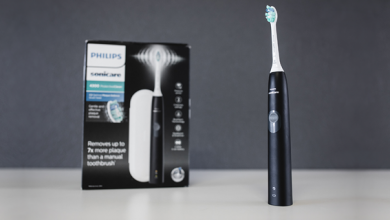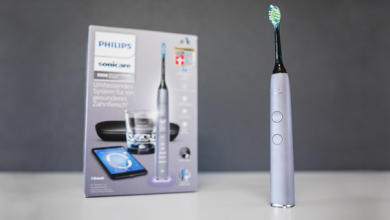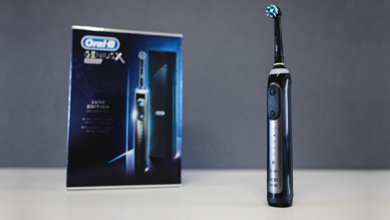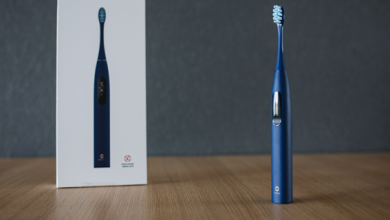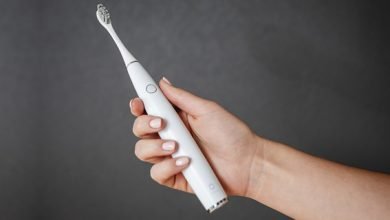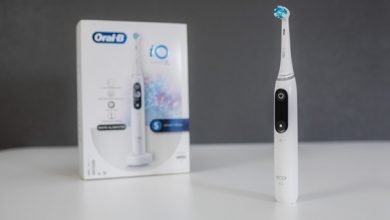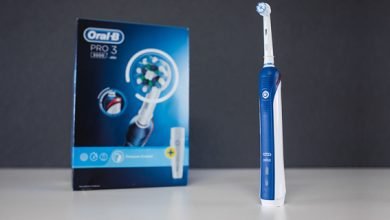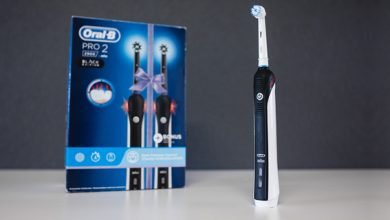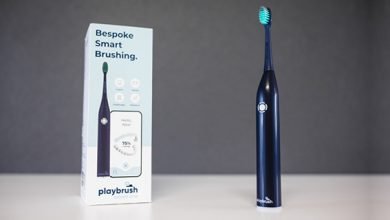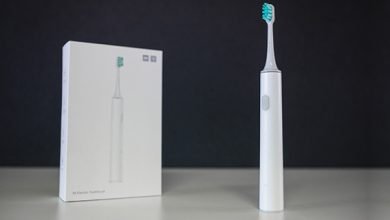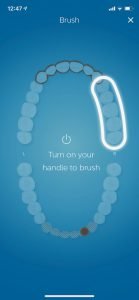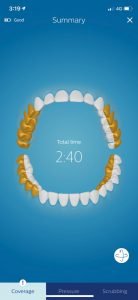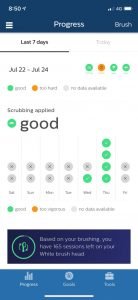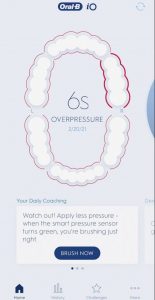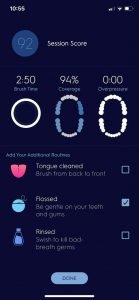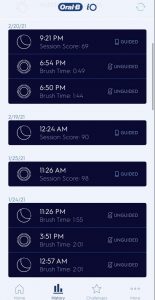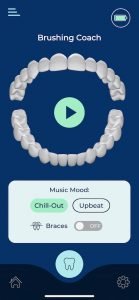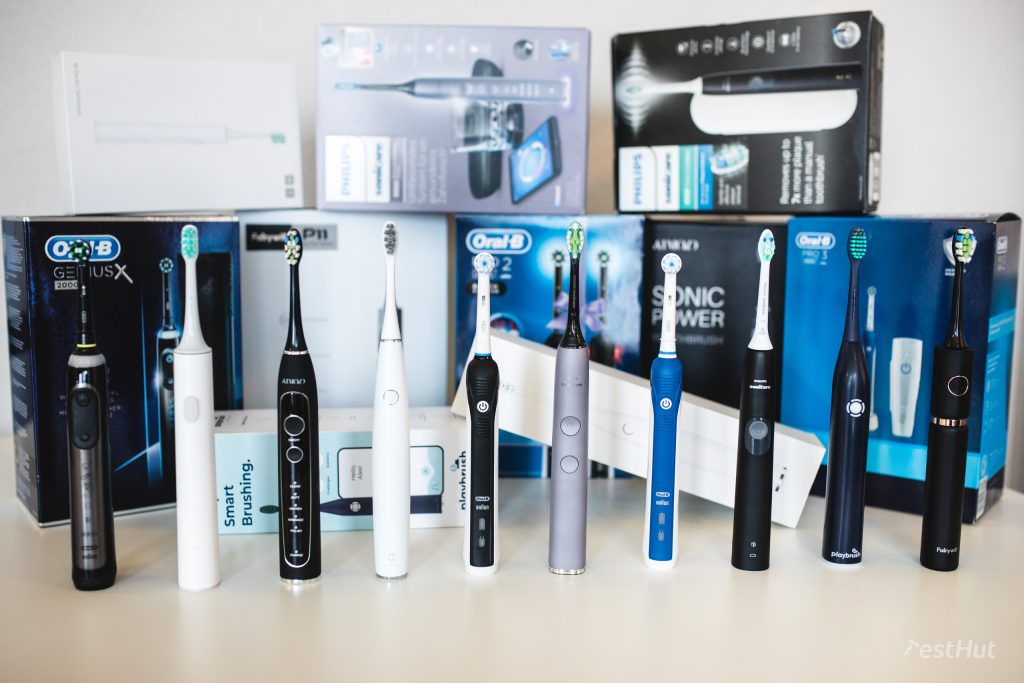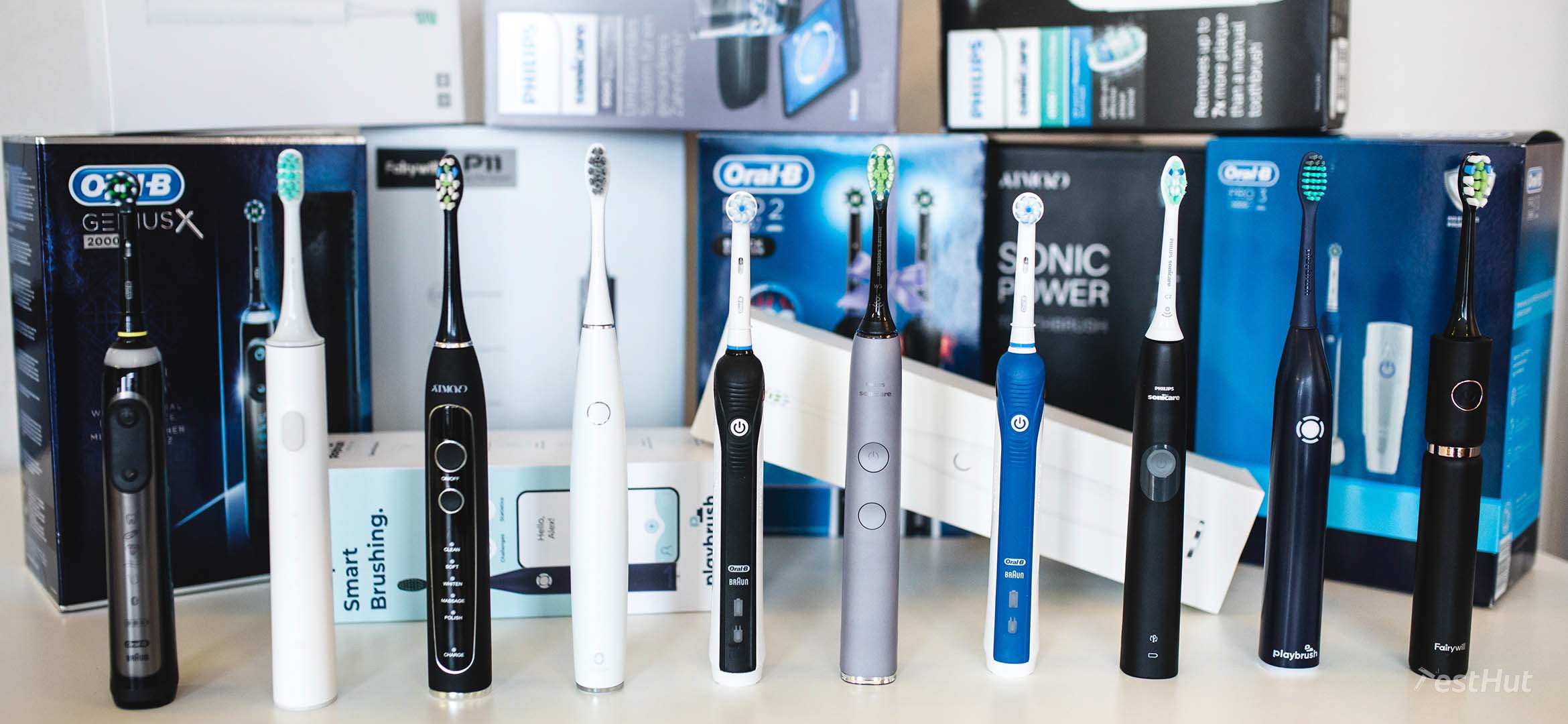
The Best Electric Toothbrush
Buying the wrong electric toothbrush is not only a waste of money, but may lead to cavities and gum recession. After researching over 300 different electric toothbrushes and choosing 12 to buy, we spent 3 months rigorously testing and scoring these brushes, and we even managed to break the most expensive one! See which electric toothbrush you should buy, and which popular brands to avoid at all costs!
TestHut’s Top Choice: Philips Sonicare ProtectiveClean 4300
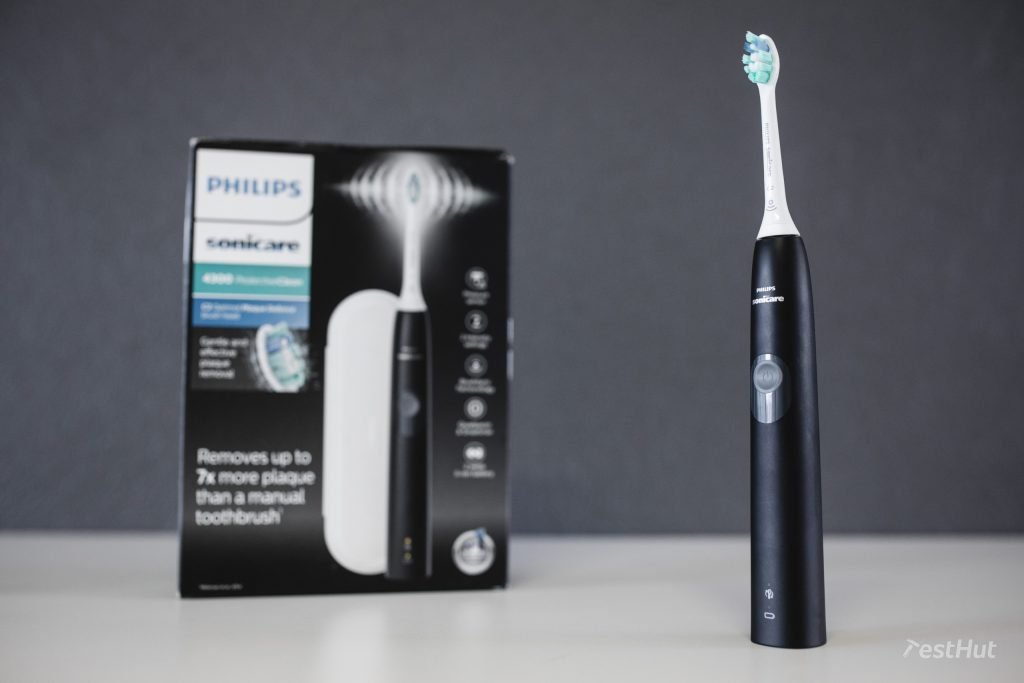
Our pick for the best electric toothbrush is the Sonicare 4300 and with good reason. After home testing, the TestHut editors took a straw poll to see which brush everyone liked the best, and this was our unanimous choice. But what is it about the 4300 that makes it such a great toothbrush?
First and foremost, it cleans better than any brush we tested. It scored 4.8/5 in the cleaning category coming in at the top of both our Feel After Cleaning and Plaque Reveal Pill tests. It was also one of the most powerful in our lab tests.
After using this brush, we felt like our teeth were “after the dentist” fresh. We had similar results from the DiamondClean and Oral-B brushes, but none of them removed plaque as well as the 4300. In test after test using plaque reveal pills, this brush was clearly the best; and not only was it number one for regular teeth, but also for our tester with irregular sensitive teeth and another who wears braces.
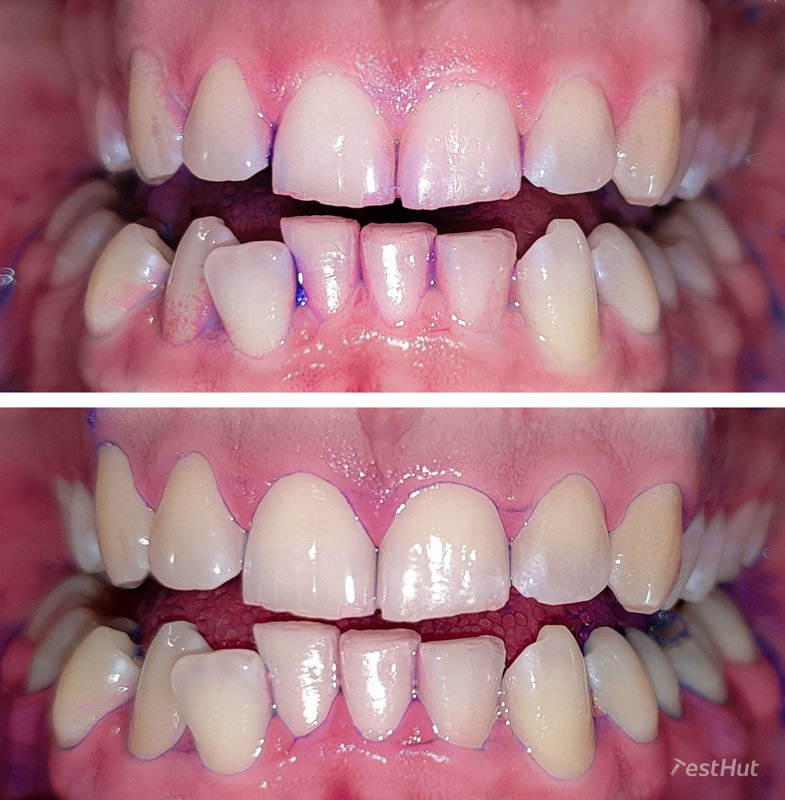
Since the DiamondClean and 4300 use the same basic cleaning action (Philips confirmed this for us), we think the difference in cleaning may come down to the smaller C2 brush head we used with the 4300 versus the larger C3 brush head we used with the DiamondClean; because of this, the C2 may have better access to those hard to reach spots.
This brush is also very comfortable to use. The handle is light and it has a nice, polished grip. Operation is relatively quiet, at just 62 decibels, so noise was not a problem. It is not as quiet as the Xiaomi Mi (54 dB), but it is noticeably more comfortable to use than the Oral-B brushes which are about as loud as vacuum cleaners at over 70 decibels.
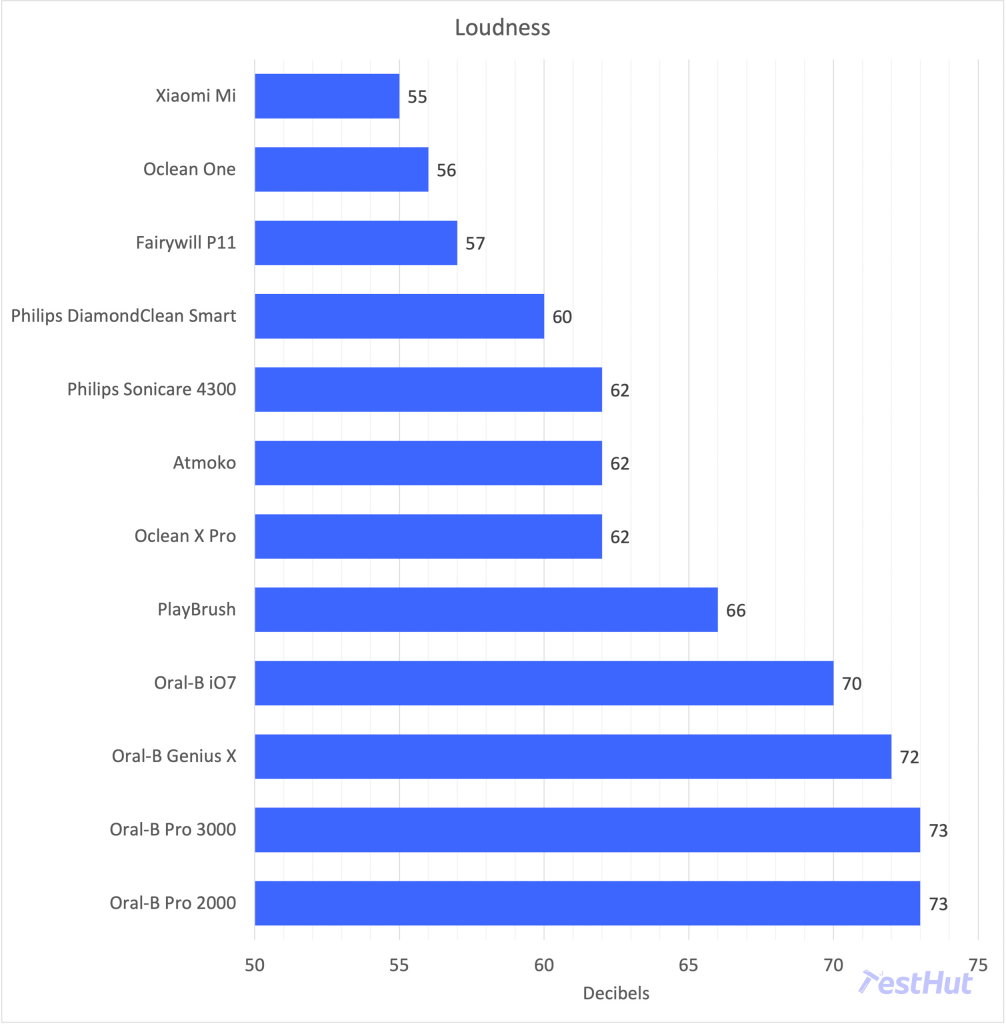
Some may find that the power of the 4300 is a bit much at first, but it does offer two intensities, high and low, along with an Easy-start feature that will slowly ramp up power for 14 days after you first start using it. This feature can be disabled if you are a long-time sonic toothbrush user.
One tester, who had been using an Oral-B brush previously, found the Sonicare to be more comfortable to use, and, even with sensitive teeth, he had no problem with its power. In fact, he switched to a Sonicare 4300 after our tests.
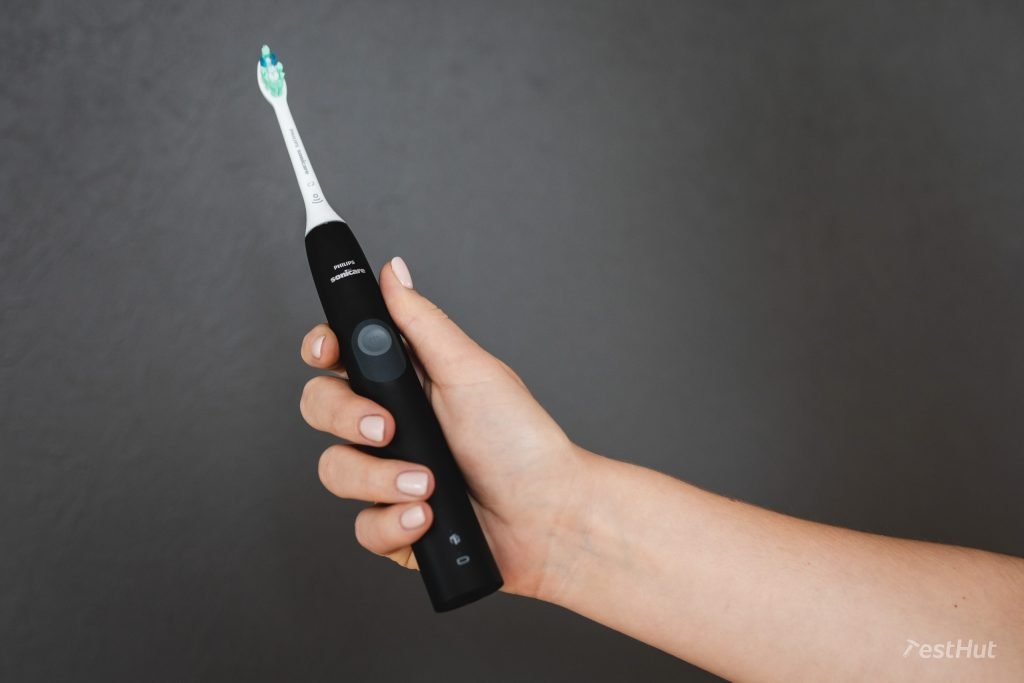
Operating the 4300 is quite simple. It only has one button which turns the brush on, and switches intensities. Some brushes, like the DiamondClean and Oral-B Genius X offer more modes and features, but in our experience, one mode is really enough to get your teeth clean.
It comes equipped with a quadpacer which means that the brush will run for 2 minutes vibrating every 30 seconds to let you know when to change quadrants. After you finish, it will shut off automatically. The Oral-B brushes and Playbrush will continue to run after time is up, and we could not agree as to which way was better. We found the quadpacer to be quite accurate, and the vibration notification to change modes was intuitive and pleasant. Some brushes, like Atmoko and Fairywill, come to a complete stop every 30 seconds which we found a bit more jarring.
The 4300 also has a pressure sensor, which we think is an important feature. Pressure sensors are especially valuable for people switching from a manual brush to an electric brush, so they can get used to the concept of letting the action of the brush do the cleaning. The visible pressure sensors work like this: if you brush too hard, a light on the handle will turn on, and the vibration speed will decrease until you ease up on your brushing.
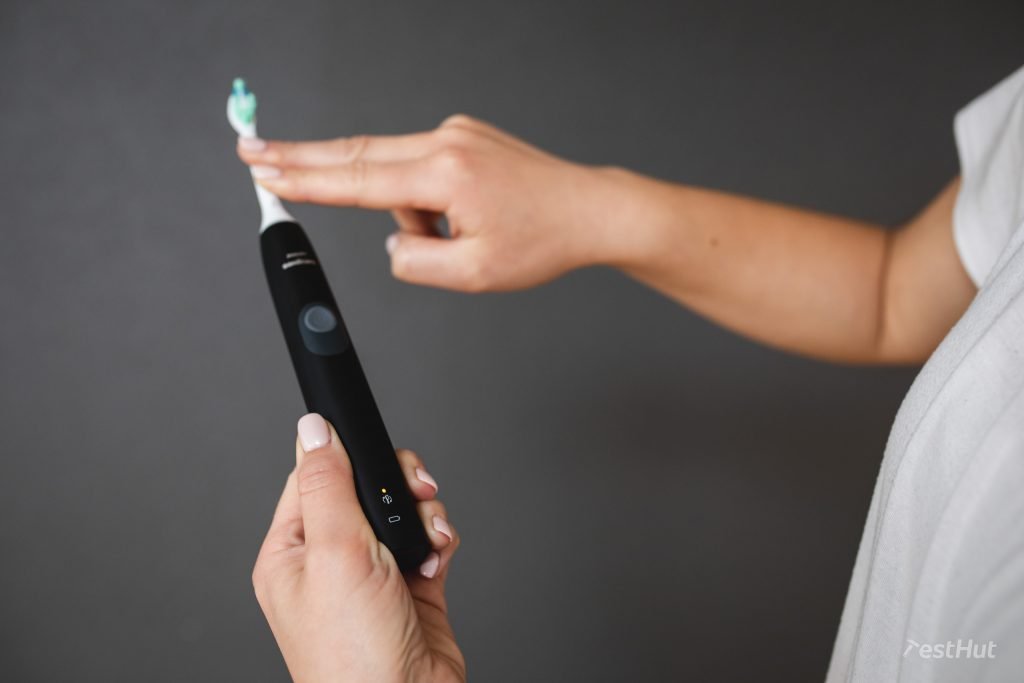
This brush had the most sensitive sensor in our test, which was a bit annoying because the brush would pause several times during a cleaning session, and the LED signal light is too small and low on the handle to notice while brushing. It triggered at about 240 grams of force while the other brushes we tested were closer to 300 grams, which felt more natural to us.
We chose the black handle for our test model, and it also comes in pink, white, grey and light blue. Philips does a nice job with the modern styling of their brushes. Some of the other brands were too decorated for our tastes like the Genius X with its combinations of different types of plastic and rubber.
Our package came with one brush head, the C2 plaque defence with a built-in chip to keep track of brushing sessions. There is a little LED light on the handle which will turn red after you have used the same brush head for 3 months. This is a nice way to remind you to change heads because it is easy to forget. Sonicare is the only manufacturer with this brush sync technology, while some other smart brushes use their apps or indicator bristles to keep track of brush head use.
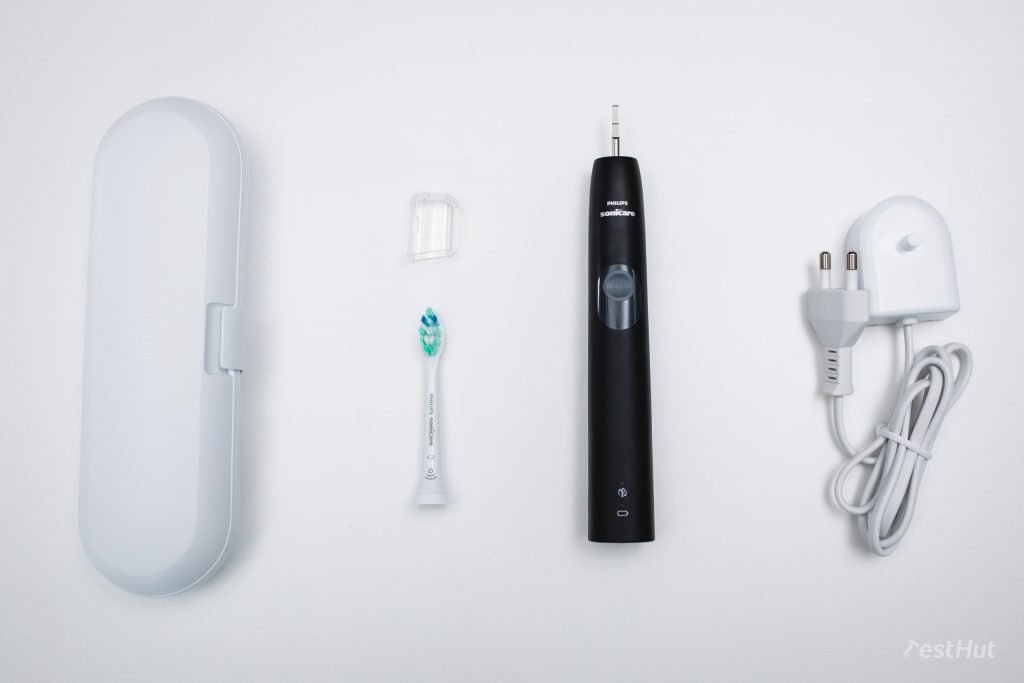
When it comes to brush heads, we appreciate the quality and availability provided by Philips. We had a chance to test several of the 2 series and 3 series brushes, and they were all high quality and effective. The sensitive brush head (G2 Optimal Gum Care) was also highly praised by our tester with sensitive gums. However, if you buy a new brush head every 3 months as recommended, you may be spending more than 27 Pounds a year on your Sonicare.
The 4300 is also well-built having passed both our drop and water immersion tests without a scratch. After falling from sink height to the hard bathroom floor, it still operated perfectly. It also has a stable base, so it will not fall over easily.
One really impressive feature of this Sonicare is battery life. We were able to coax over 49 days worth of brushing from a single charge! Philips claims just 2 weeks, so it overperforms in this category.
The average tested battery life for all our brushes was about 30 days, so this is well above average.
Update: After field testing the brush for 6 months, we found that practical battery life over time is closer to 32 days between charges. This is still more than double the claim from the manufacturer.
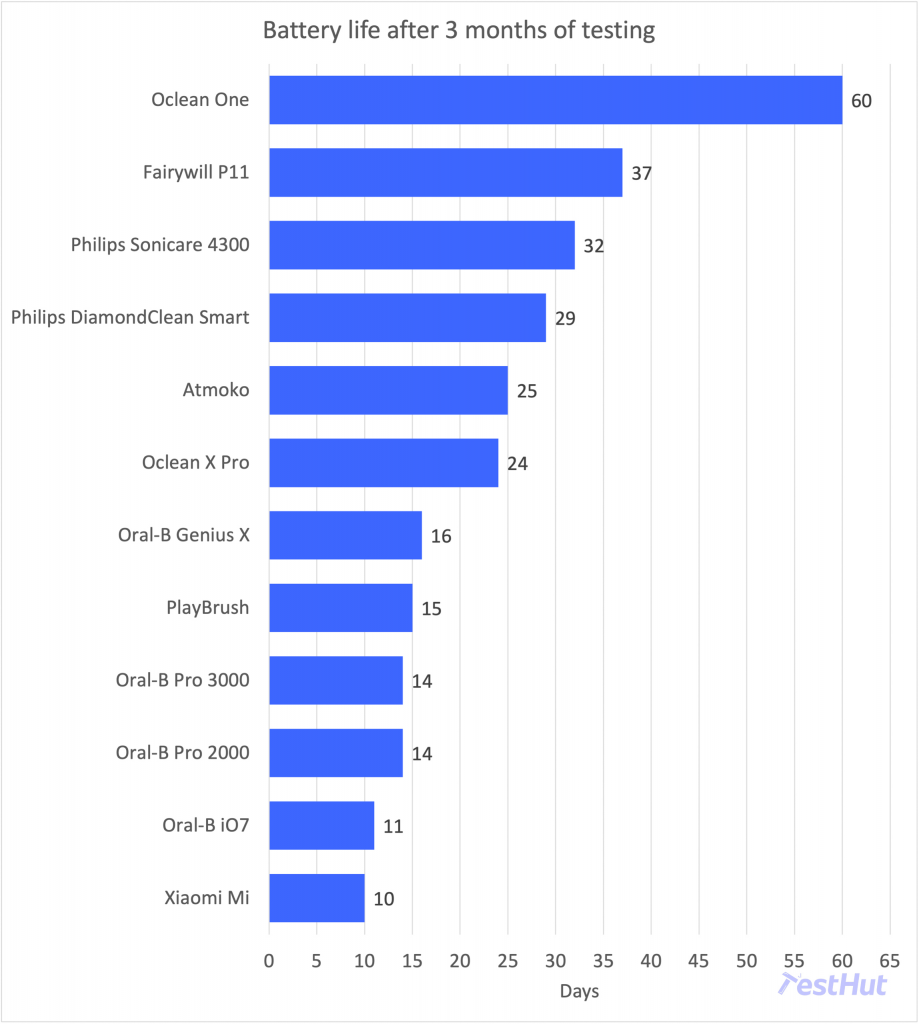
It comes with a standard induction charger that will fully charge the battery in about 13 hours, which is on par with most of the other brushes we tested.
The handle has a small battery indicator light located near the bottom which starts to blink green when the battery is about 65% full, then amber when it is 10% and then the brush will beep and turn off when the battery is completely dead. We do prefer other brushes that have apps with actual battery percentages available or even a 3-tiered LED which shows how much battery life is left, but this signal is pretty clear.
Our brush came with a single brush head, induction charger and basic travel case. It earned a low score for its box contents mainly because we felt that the travel case was low quality.
What we didn’t like
Yes, the 4300 is a great brush, but there are some things that could be better.
While we like the single button for operating the brush, the intensity switching can be a bit confusing. The brush shuts off automatically after two minutes, but if you try to turn it off manually, you will end up going through the two intensity settings, and then when you brush again, it will start in the lower intensity. The right way to do this is to hold the button down for a second to shut it off so it starts up in the same intensity you were in before. When testing, sometimes we found that we were accidentally in the lower intensity mode without knowing it because there is no indicator light on the handle. We would like to see a mode indicator light so we know which mode we are in at all times.
The travel case was our biggest disappointment because it felt cheap, and neither held the brush securely nor latched properly. One of our testers discovered that the case had opened up while traveling, and the brush fell out. We hope that we just happened to get a dud because this case was terrible. This brush deserves a much better travel case than this cheap plastic model that does not even stay closed.
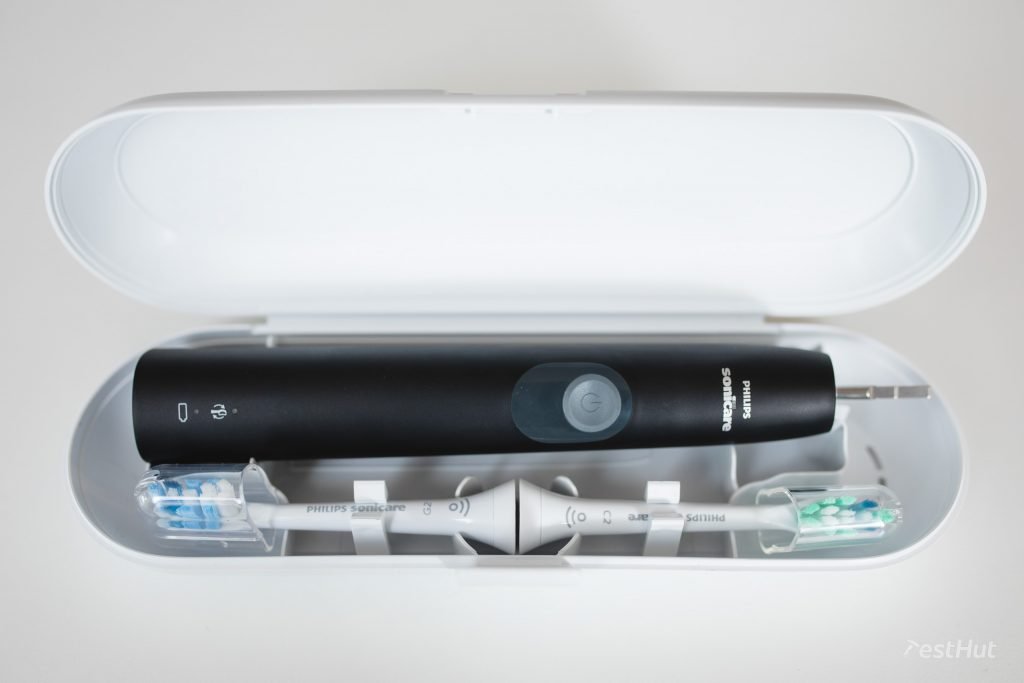
Conclusion
Overall, the Sonicare ProtectiveClean 4300 offers the best electric toothbrush experience at a decent price. We think this is a terrific brush that you will enjoy using day in and day out. It comes with a 2-year warranty, and we will continue to perform long-term tests with our model and update you with results.
Premium Choice: Philips Sonicare DiamondClean Smart
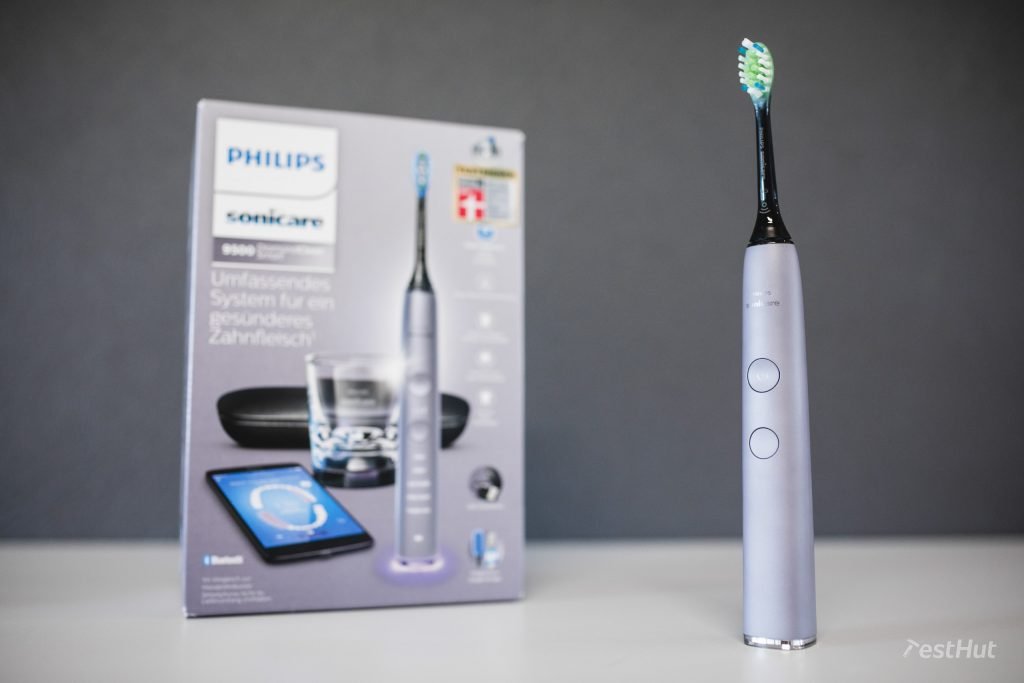
The highest scoring brush overall was the DiamondClean Smart, and it should be for as much as it costs! It is the most expensive brush that we tested, but for that price you get a very luxurious toothbrush that does a great job cleaning your teeth along with a nice set of accessories.
Basically, you get a brush that cleans about as well as the 4300 but includes more modes and a Bluetooth connected app along with some nice accessories. If money is no object, then this brush is for you!
The DiamondClean scores very high in all the cleaning categories, employing the same basic mechanics as the 4300. It is a powerful brush that gives you that “after the dentist” level of clean. It was not as powerful as the Playbrush in our lab tests, but it is more than enough to get the plaque off your teeth.
Our brush came with the series 3 Plaque Defence brush head (C3) which is a bit larger than the series 2 brush head that came with our 4300. We believe that this different brush head may account for the different plaque removal scores between these two brushes.
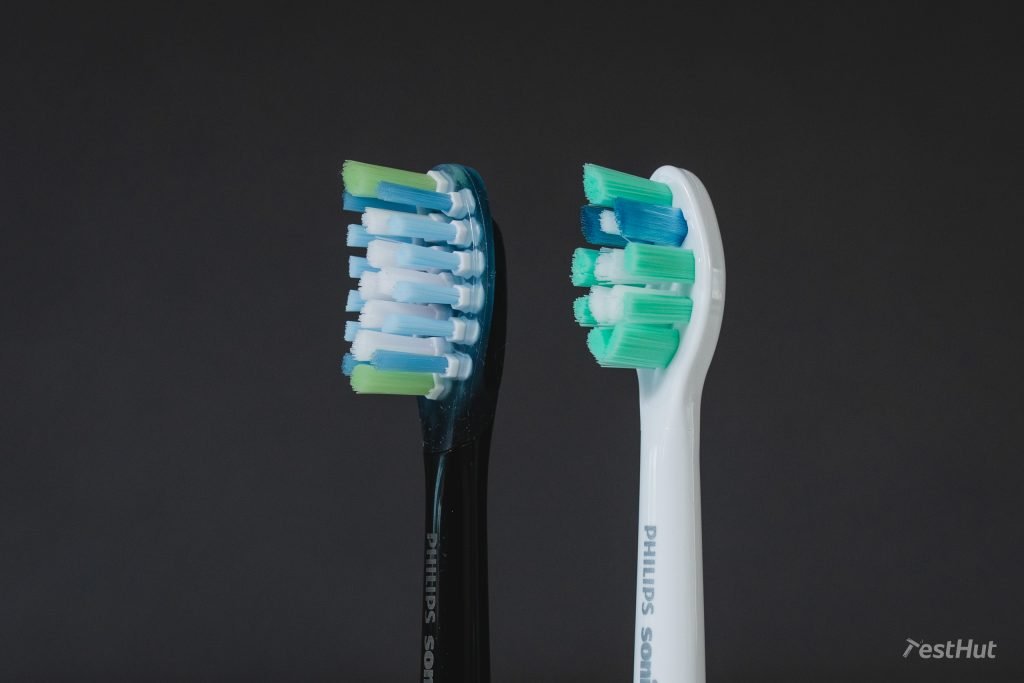
The DiamondClean scored the highest of any brush in the Comfort category. One reason for this is that Philips Sonicare brushes are well-made, very comfortable to use, and they come in a variety of styles. The DiamondClean is compatible with the newest series 3 brush heads as well as older brush heads.
We found that this brush was one of the quietest to operate at just 60 decibels, which is the sound of a normal conversation, and it is much quieter than the Oral-B brushes (over 70 dB). It is also lightweight with a satin-finish grip that fits very well in the hand.
There are two buttons on the handle, one to turn the brush off and on and the other to change modes when the brush is off, and then adjust intensities while the brush is running. We do like the feel of the 4300 buttons better than the DiamondClean. Some users have complained about the space between the buttons and the body getting gummed up during operation leading to malfunctions. Philips even addresses the issue in their FAQs.
This brush is loaded with features. We have said before that we do not think that modes and features make the brush any better, but it is important to understand what you get when you buy this brush.
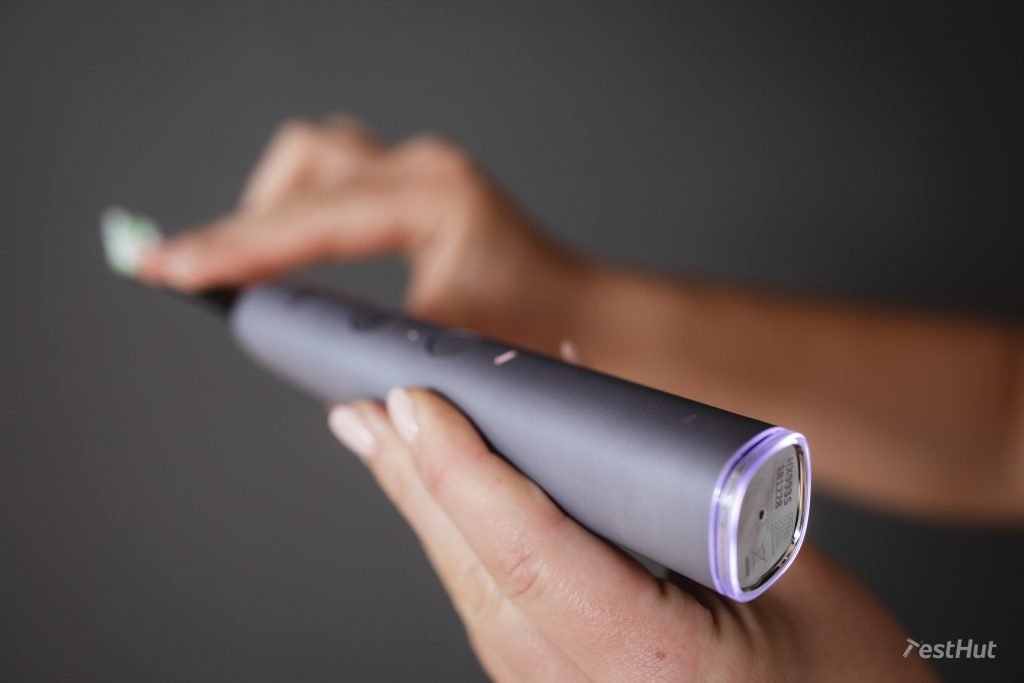
The DiamondClean has a visible pressure sensor to alert you if you are brushing too hard. We found that this sensor will trigger right at 300 grams of force, which, based on our research, is what experts recommend for electric brushes. To alert you that you need to ease up, the vibrations slow down, and an LED light at the base of the brush flashes. If you are not looking in the mirror while brushing, this light is not very noticeable. When I was testing, I noticed that the Oral-B 2000 and 3000 have much brighter visible sensors which I could even see when brushing with my eyes closed.
While most of the brushes we tested use quadpacers with 2-minute timers (training you to divide your mouth into 4 quadrants cleaning each one for 30 seconds), the DiamondClean Smart uses a hexpacer dividing your mouth into 6 section for 2 minutes vibrating at 20-second intervals. To learn how to best use this feature, the instruction manual has a map of your mouth with suggestions, and the app will guide you through the cleaning when you connect the brush. When trying this for the first time, I felt that 6 sections makes a 2-minute brushing session go by fast, but it takes a bit of getting used to.
One big difference between the 4300 and the DiamondClean is that this brush comes with 5 modes (Clean, White, Gum Health, Deep Clean and Tongue Clean) that are clearly marked in English on the handle. Each mode can be set to 3 intensities—low, medium and high. For the most part, we used the regular cleaning mode in our tests, and didn’t find any real benefit to using the other modes. They change vibrations, and some modes give you more brushing time, but ultimately the cleaning performance was not noticeably better.
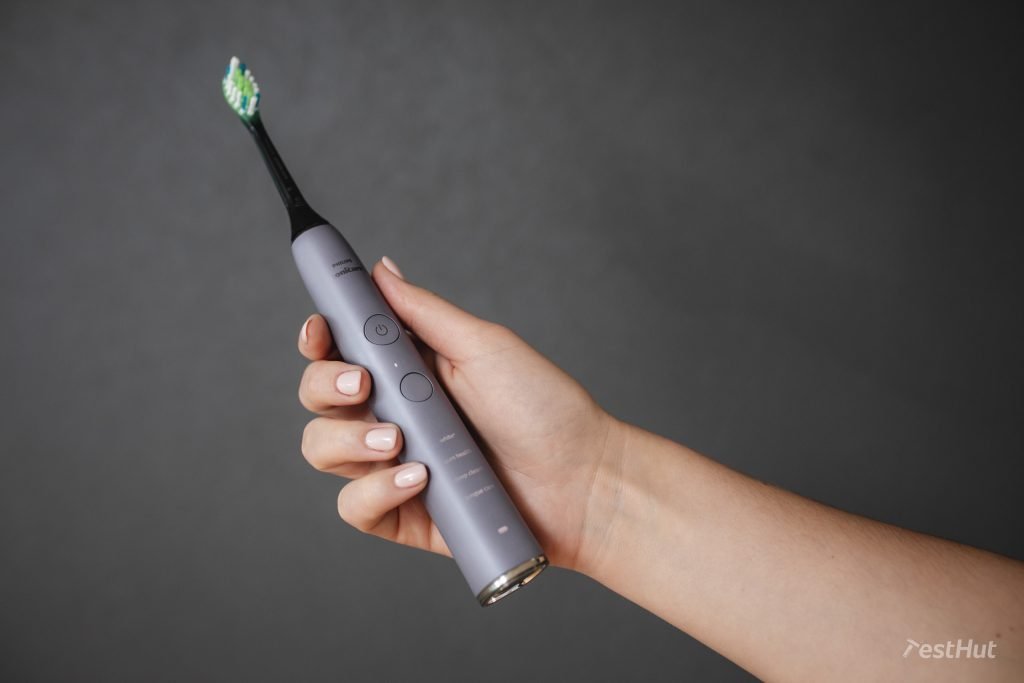
Like the 4300, the DiamondClean has brush sync technology to recognize the chips in the brush heads, and not only will it tell you how long they have been used, but it also automatically syncs the mode to the type of brush head you attach. For example, we started with the Clean mode when we attached our C3 brush head, but when we switched to the W3 (Premium White) brush head, the handle automatically changed to the White mode. You can override the automatic choice by selecting the mode you want. For us, this is a take it or leave it feature—it might impress your friends and family, but it isn’t that practical.
We love the look of the DiamondClean Smart. It has clean lines, and ours came in a cashmere grey colour that is both classy and looks good with both white and black brush heads. You can find DiamondClean brushes in an array of colours including pink, black, cashmere grey, and lunar blue.
This brush passed our durability test without any problems. We dropped it from the sink to the hard bathroom floor, and it still worked flawlessly. Then we submerged it in a sink full of water to test the water resistance, and it started up and worked fine after the test. It is also the most stable brush we tested. It is well balanced, and is hard to knock over.
The DiamondClean Smart’s battery life is better than the manufacturer’s claim of 2 weeks, but not quite as stellar as the 4300. We got about 37 days of brushing on a single charge, but charging time was long at 18 hours. We think that this may be due to the induction charging cup.
Update: After 6 months of field testing, the battery life is about 29 days between charges, so there has been a little drop off, but it is still well above the manufacturer’s claim.
The battery indicator on the handle will show 4 levels of charge, but it is a bit hard to see. The app displays the battery life, but you have to swipe through 3 screens to find it.
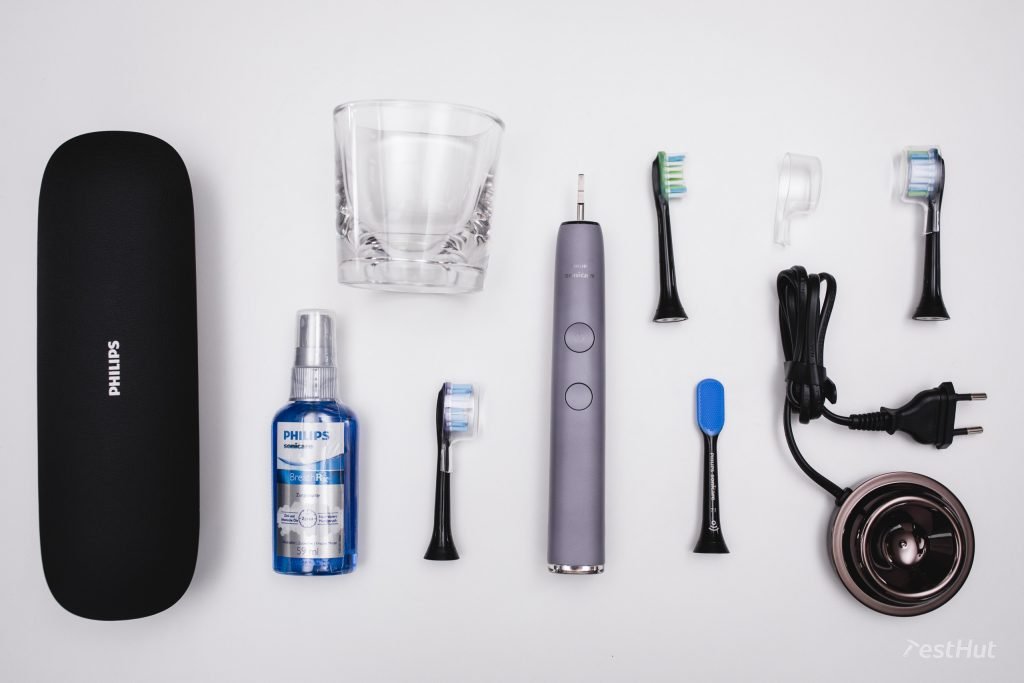
Where the DiamondClean Smart really shines is in the box contents. We ordered an older DiamondClean Smart (HX9924/43) which comes with the handle, 3 brush heads (C3, W3, G3), a premium travel case, the charging base, and the special charging cup. It also comes with the tongue cleaning kit which includes a special tongue brush and mouthwash. When you buy a DiamondClean, there are several versions of it, so pay attention to the box contents to make sure you get the most for your money.
One of the unique things about this brush is the charging cup. This is a glass cup that doubles as a charger. You set it on the induction base, and drop the toothbrush in and it charges. We love the idea of this, but if you have a small bathroom, it might be hard to find a place to keep the glass cup with the charging base.
We really like the travel case that comes with a built-in charger powered by a USB cable. This is a smart idea because you can charge on the go using any USB charger, so if you are in another country with different outlets, you don’t have to worry about having the right voltage converter. The charging case does not have a built-in battery pack, however, so you will need to plug it in to charge the brush. It is also stylish and looks fashionable with the premium feel of faux leather.
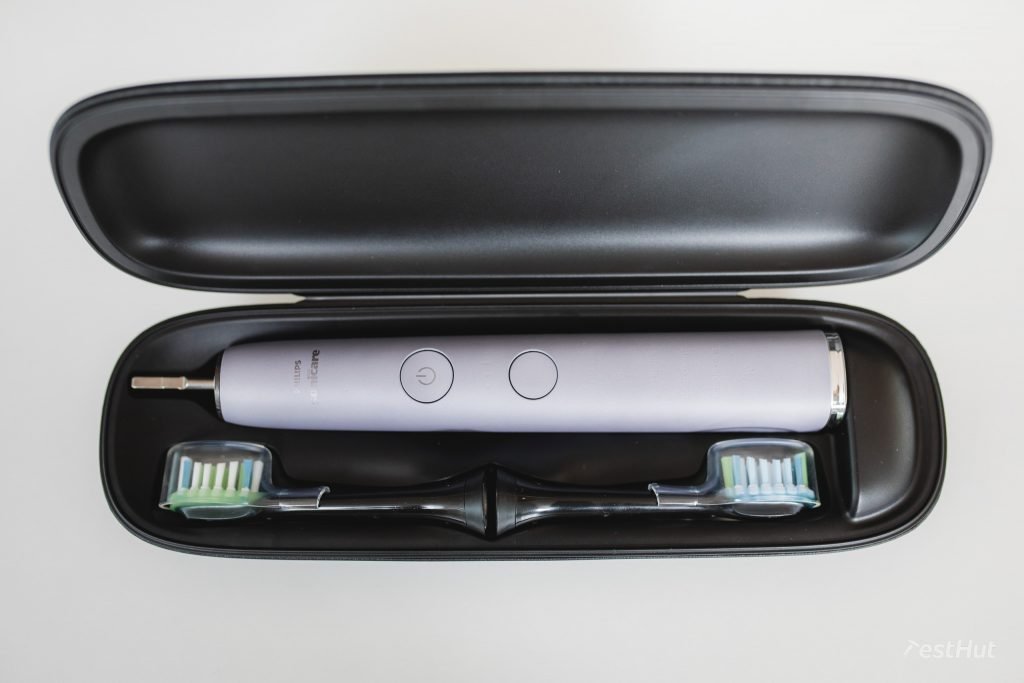
Smart Features
When you buy a Philips DiamondClean Smart, what you are really paying for are the smart features and connectivity that the brush offers. Here at TestHut, we have come to the conclusion that electric toothbrush users will not gain much from having a smart toothbrush.
At first, we kind of liked the Philips app for its simplicity and ease of use. But the more we compared it to other apps, and after Oral-B updated theirs, we found that it was not that great.
In order to use the app, you must sign in using an email or other identifier, and you give Philips permission to track your use of the app. We are not big fans of this, and we preferred the Oral-B option of using the app without logging in.
The Bluetooth connection worked fine for 2 of our testers, but the 3rd tester had lots of problems with disconnecting while using her iPhone 7.
The best feature of the app is the smart coaching feature. The idea here is that you see a 3D display of teeth, and the app guides your brushing to sections of your mouth, and as you brush, it keeps track of how well you cleaned each section. After you finish, it gives you a score telling you how well you did, and it will even suggest that you touch up spots where you may not have been as thorough. We really like the idea of touching up after brushing for a better cleaning, but the detection is not 100% accurate, so sometimes the app will tell you to touch up in places where you know you have already brushed.
Only the Oral-B Genius X and Playbrush have similarly advanced real-time coaching with their apps. We think that Oral-B does the best job because it allows you to brush in your own way during your session, while both Playbrush and Sonicare make you follow their timing and pacing.
Another app feature includes session tracking, so you can see how many times you have brushed and for how long. However, a setback of this brush is that it does not store your brushing data. Other brushes will keep track of your sessions even if you are not connected to the phone, but you must brush with your phone when using the DiamondClean Smart. I found myself ready to brush, with toothpaste on the bristles only to remember, “Wait, I need to get my phone!”
It has an easy-to-follow brush sync screen that tells you which brush head you are using and for how long you have used it. It also includes goals that incorporate the brush’s modes to help you improve your oral health. We found these to be more gimmicky than useful. We would rather control our own brushing sessions, but new users may like setting goals and following preset programs.
Overall, the app feels a bit dated compared to the graphically friendly Playbrush app and the improved Oral-B app. It is text-heavy, and you find yourself swiping through too many screens to find basic information like battery life.
What we didn’t like
A major problem with our test brush was that the first one we tested failed after just 1 charging session. It refused to turn on. We contacted Philips and were very happy with their customer service. They were able to replace our broken brush with a brand new one in just 2 working days.
We deliberated whether or not a failure meant that we could not recommend this brush at all, but we feel that one faulty model does not necessarily mean that the whole DiamondClean Smart line should be condemned. When we analysed online reviews, we did not see a pattern of failure for this model. Customer service was excellent, so we still recommend the brush. The new one is working fine, and we will let you know if there are any problems during our long-term testing. It comes with a 2-year standard warranty, but hopefully, we will not have any more issues with our test brush.
For a smart brush, it would be good if there was a Bluetooth indicator light to let you know that the brush is connected to the app. We had a few dropped connections while testing, and there is no excuse for this.
Another smaller issue is the way you change modes and intensities. The brush comes with two buttons. The top one will turn it off and on, and the lower one will change modes when the brush is off, but once it is running, the button will only adjust the intensity of your cleaning. This means that if you want to change modes while brushing you have to turn the brush off first.
We love the charging cup, but we think that a brush this pricey should also come with the alternative charging puck that some DiamondClean models include. This puck would give you the option to charge in the glass or on a more standard induction stand which has a smaller footprint.
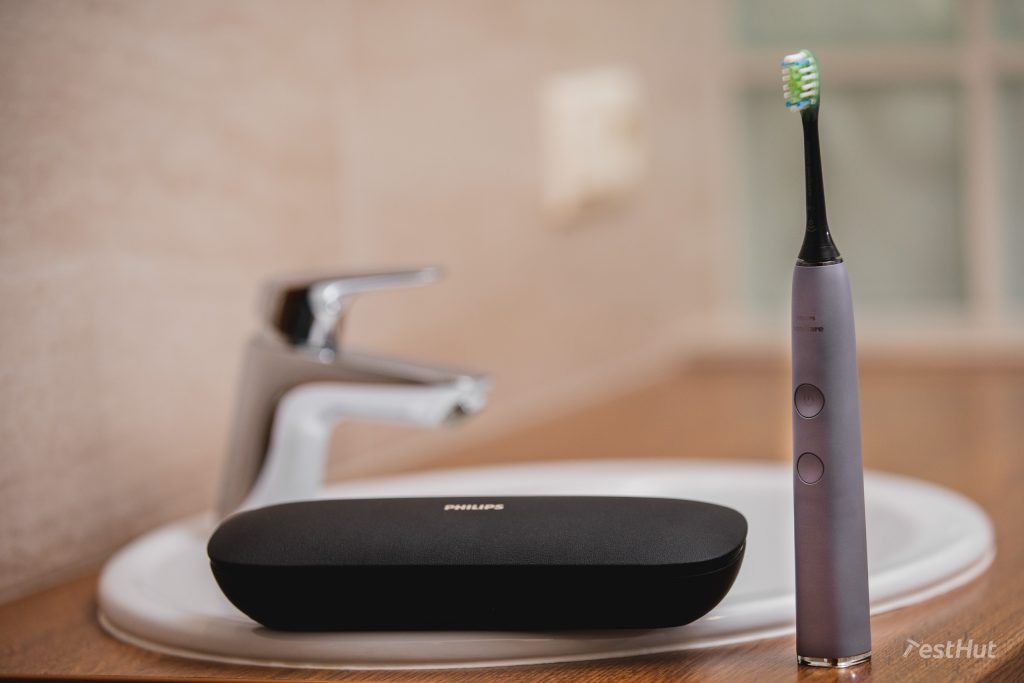
Conclusion
We liked brushing with the DiamondClean Smart. It is a very good toothbrush that cleans very well and offers lots of bells and whistles. Again, we would opt for the lower-cost 4300, but if you have deep pockets and really want a smart, connected toothbrush with impressive box contents then this is the best one to have.
Best Smart Brush: Oral-B Genius X
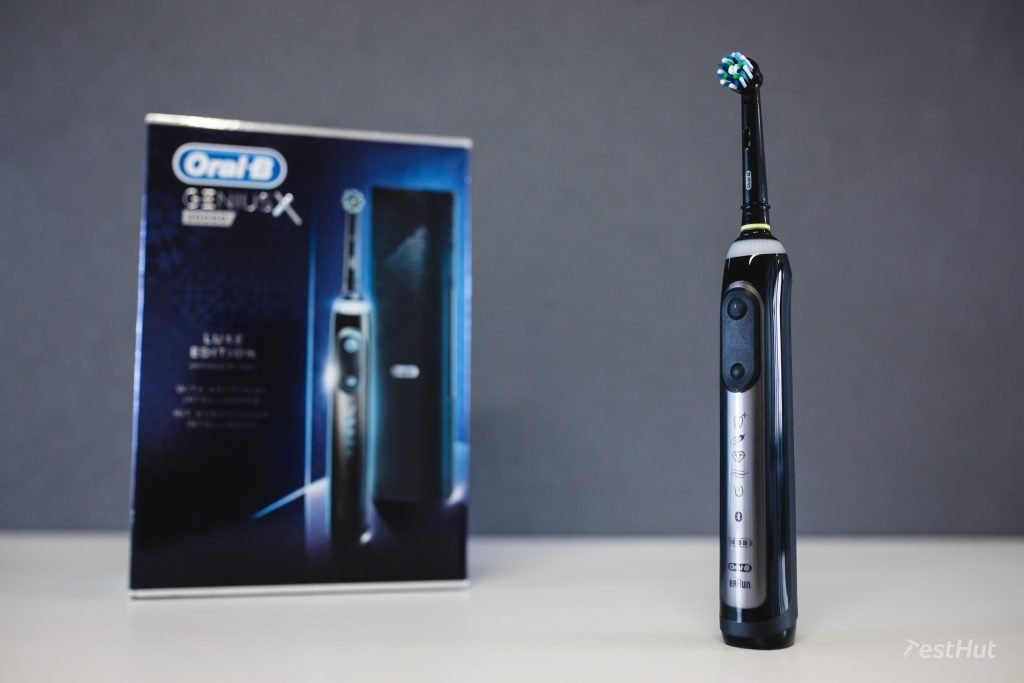
This flagship model from Oral-B is our choice for Best Smart Brush. The Genius X scored very well in all of our tests, and it offers the best smart features of any of the smart brushes we tested.
The Genius X is very powerful with its round head oscillating 9,000 times per minute, and it cleans well. When we tested, it was near the top of our plaque test and always performed well in the lab tests for power. However, we found that it does not clean as well as the Sonicares in head-to-head plaque tests. In our trials, it had difficulty cleaning the hard to reach spots between teeth, especially if the test subject had irregular teeth.
We really like the grippy handle which has a nice rubberized back—it seems to fit in the hand just perfectly. It also features two responsive buttons which allow you to turn it off and on with one and change modes with the other.
As a top-of-the line model, this brush comes loaded with features. As we have said, we are not overly impressed with modes, but this one comes with 6 modes including a low-power tongue cleaning mode. It has a precise quadpacer, guiding you through your brushing session.
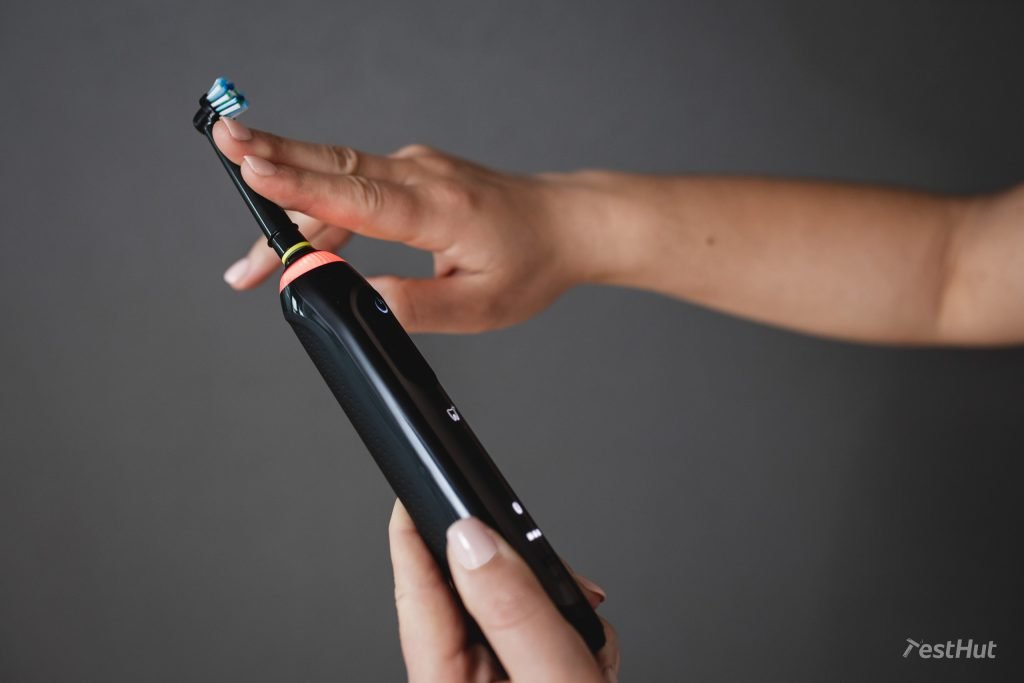
One unique feature of the Oral-B Genius series is the customizable light ring at the top of the handle. This LED colour ring can be adjusted via the app allowing you to personalize your Genius X. It also doubles as a pressure sensor which we like because of its consistent accuracy (triggering at 300 grams of force) and visibility as the LED light turns bright red when you need to ease up on your brushing.
While not as modern and sleek as the Sonicare and Oclean models, this is a well-built toothbrush that is sturdy and durable, passing both our drop and water immersion tests with ease. It feels like it will withstand the occasional fall from the bathroom sink onto a hard floor over and over again.
One drawback to all the Oral-B brushes we tested is that battery life is only average. We were able to get full-powered brushing for 17 days, and it took over 12 hours to charge. The handle displays 3 LED lights that will turn red when the power is almost gone. The app also has a battery life display.
Update: After long-term testing our Genius X for over 6 months, we have seen a slight decline in battery life. It is now giving us 16 days of brushing on a single charge. So it is still running strong.
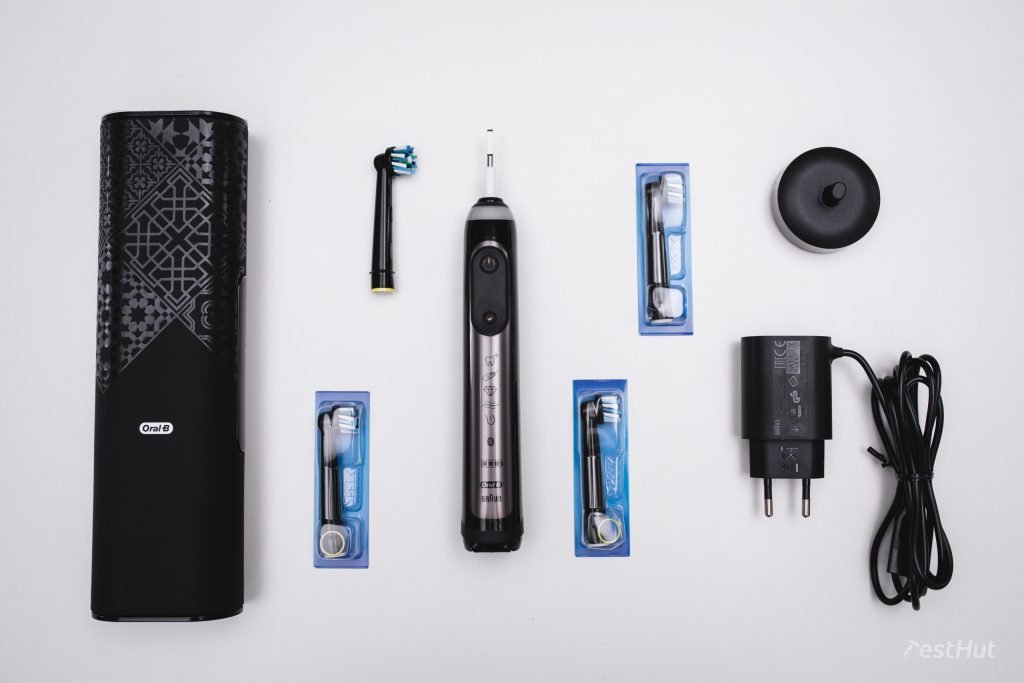
We opted for the Genius X Luxe model which came with a deluxe travel case, and 4 CrossAction brush heads, which is a year’s supply. The stylish case is practical with its secure locking mechanism and offers peace of mind when you are on the go. The only drawback is that if you want to charge while traveling, you have to pack the bulky power brick separately.
Another advantage of buying an Oral-B is that it gives you access to a wide variety of brush heads. We tested this brush with the CrossAction, SensiThin and Trizone heads to name just a few. Each one offers a slightly different experience which means that you can customize your brushing just by changing brush heads.
Smart Features
The Genius X really shines when you use it as intended with the Oral-B app. While we were not blown away by any of the smart features offered by any of the brushes, the Genius X did the best job overall.
First of all, we like that you can jump right in and start using the app without creating a login or having to sign in. The Bluetooth connection was also the most reliable of any brush we tested. None of our testers lost the signal while brushing which happened at least once with our other smart brushes. Oral-B also recently updated the user interface to make it more pleasant to use with cleaner graphics and easier navigation.
The Genius X has an advanced real-time brushing coach with a detection system that can tell where in your mouth you are brushing to help you figure out how to get your whole mouth clean. The other brushing coaches from Philips and Playbrush are limited because you have to follow their brushing regime in order for them to recognize where you are brushing. Oral-B is the only one who has the technology to actually track your brushing habits as you freely brush your teeth. We would still recommend dividing your mouth into quadrants and brushing each for at least 30 second to get full coverage, but the app will follow along however you choose to brush.
Furthermore, the brush handle will store your data, so if you forget to take your phone with you when you brush, it will sync the data next time. You won’t have real-time feedback unless you brush with the phone, but you can at least keep track of your sessions.
It also offers customizable journeys which allow you to specify areas of oral care to work on such as Fresh Breath or Gum Health. We were not super impressed with these journeys because once they were activated, they limited our ability to choose modes and try other options. But someone using the brush long term might find these more useful.
In addition, the app keeps track of your brushing habits and incentivizes you to brush often by offering challenges so you can earn medals for your efforts. We think that one thing these apps can do to improve oral health is to incentivize brushing, so this might be one more thing to help you remember to keep up your good brushing habits. I was just showing off my “Midnight Brusher” medal to a colleague.
This is the only app we tested which pairs with the Apple Health app. It only tracks your brushing frequency, but if you like all your health data in one place, then this is the brush for you!
The app will also keep track of how long you have used your brush head, so you know when it is time to order replacements.
What we didn’t like
This is not the most comfortable brush to use. It is noisy, measuring at over 70 dB, which makes it almost as loud as a vacuum cleaner. When you use it, you cannot hear anything else at all.
The powerful oscillations and vibrations are also a bit harsh, especially for sensitive teeth and gums. As a 10-year veteran of electric toothbrushes, I was surprised that the brush bothered me, giving me sore gums after just a few sessions. I swapped my CrossAction brush head for a Sensitive one, and finished the test trying the sensitive mode to see if that would help. It did, but it also made the cleaning less than satisfying.
The two buttons on the handle are nice to have; however, for some reason, the mode switching feature is disabled when the brush is not running, so you have to turn it on to switch modes which will splatter toothpaste everywhere. We would like to be able to select the mode prior to starting the toothbrush to avoid the toothpaste tornado!
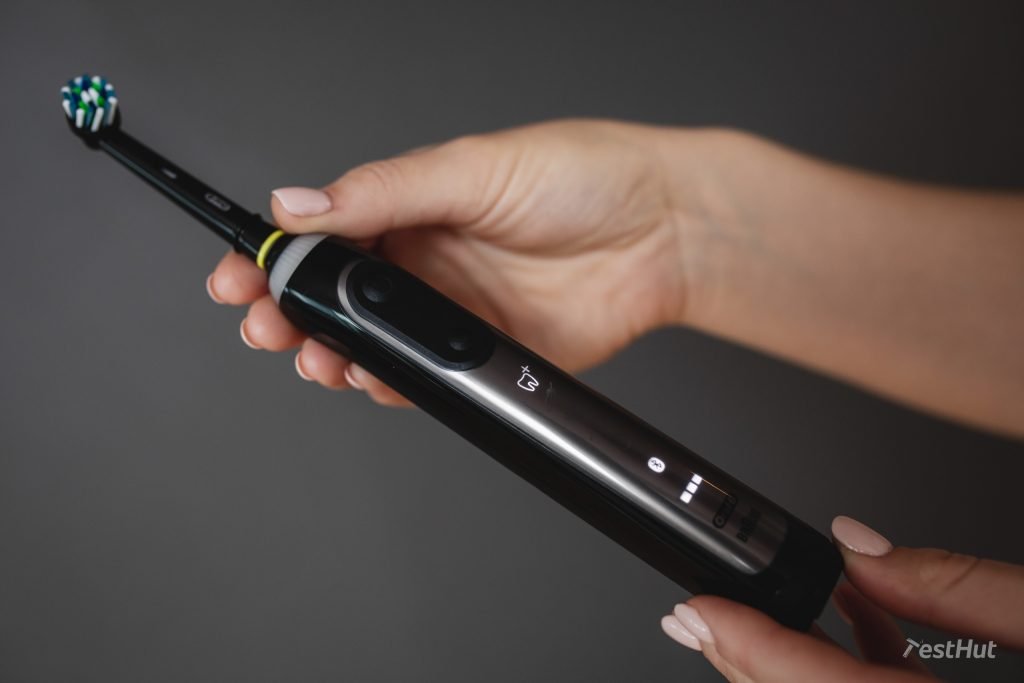
Another thing we do not like about Oral-B brushes is that they cut cleaning power once the low-battery light comes on. This means that you can be in the middle of a brushing session, and suddenly you only have a weak motor to finish cleaning. Other brushes will run on full power until they are completely out of juice.
Conclusion
Overall, the Genius X is a solid electric toothbrush and the best smart brush that we tested. It is a bit pricey, but you get plenty of great features, a useful app, and powerful cleaning for the cost.
Best for Travel: The Oclean X Pro
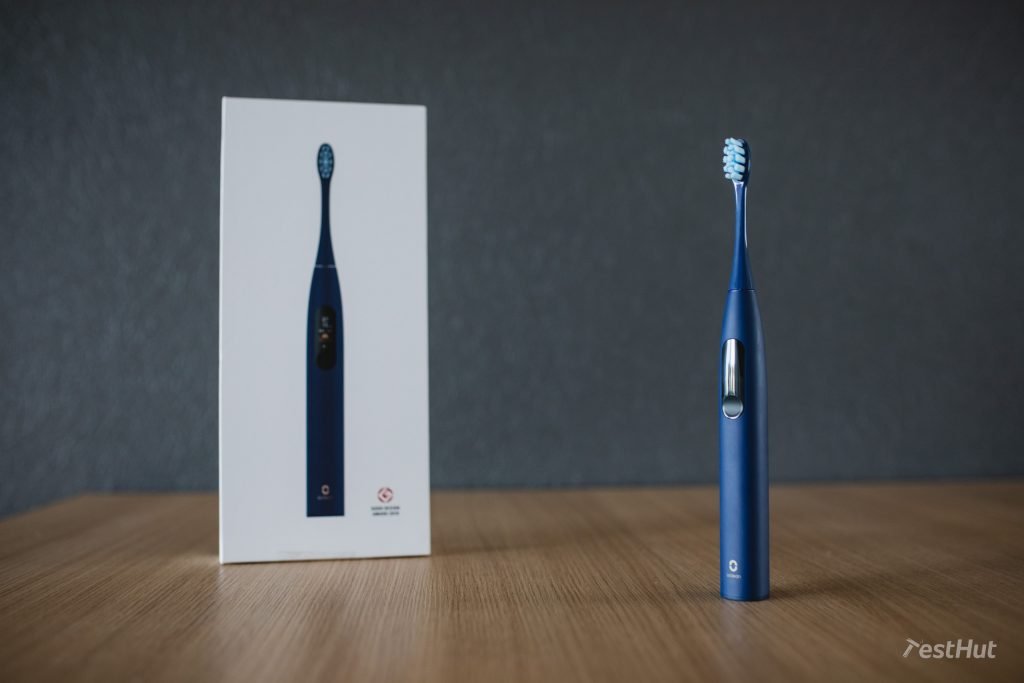
This relative newcomer really took us by surprise. It is light, easy to use, has terrific battery life and, with its compact travel case, makes an excellent companion on the road. This is the only brush in our tests that has a built-in full-colour LCD touchscreen, and we think it is pretty cool that the toothbrush starts up displaying the date and time giving you info at your fingertips.
The X Pro model scored very well in our cleaning test, earning a 4.3/5 score. It gave that fresh feeling after we cleaned, did well in our plaque test, and showed ample power in lab tests. However, the brush comes with 32 power settings, and it is preprogrammed to operate initially at level 18 which we felt was underpowered. Once we figured this out and ramped it up to full power, we found the cleaning to be more than adequate.
It earned high marks for comfort, earning the same score as our top choice, the Sonicare 4300. It is very light and easy to handle, quiet (just 62 dB), and it is simple to operate. The touchscreen is a bit small and not as responsive as we would like, but once you get used to the controls, it does offer lots of customization at your fingertips along with information about your brushing habits. We like the idea of accessing smart features of the brush without having to use the app on our phones.
For a relatively low-priced smart brush, it has a decent set of features. It offers customizable brush times via the touchscreen or app, and you can choose from 4 modes including Cleaning, Whitening, Massage, and Sensitive. We found ourselves using the Cleaning mode at the highest intensity for our daily cleaning regime.
One thing we really liked about our X Pro was the design and build quality. The seamless handle came in a beautiful navy blue, and it easily passed our durability tests. You can also get it in pink, black, and mint green. One minor issue is that the seam between the touchscreen and handle has a tendency to collect toothpaste and other bathroom grime, so it means keeping it clean may take a bit more maintenance.
Oclean is doing a great job with the battery life of their brushes. While not as impressive as the Oclean One’s 60-day battery life, the X Pro did give us a full 24 days of brushing on a single charge, which is enough to get you through most trips that you might take. It also comes with a decent mag charger which will fully charge the brush from any USB outlet in less than 2 hours, much better than most of the other brushes we tested which took an average of 13 hours to charge. There is a battery indicator on the touchscreen, although you have to scroll to find it. The brush will give a screen notification and a beep when it is below 15%.
Update: After testing the brush for 6 months, the battery life is still 24 days between charges.
Our package came with a travel case and brush head cap. One unique accessory is the magnetic wall-mounted toothbrush holder. It has a self-adhesive backing allowing you to save counter space and store the toothbrush neatly on any wall. It came with 1 standard brush head, and because Oclean brush heads can be hard to find, we would recommend ordering extra ones right away.
We found the standard travel case to be one of the most functional that we tested. It does not include a charger like the premium models from Philips or Oral-B, but it is light, fashionable, and it stays shut tightly when traveling keeping your brush safe and secure. It is also the lightest brush and travel case combo out of all the brushes we tested weighing just 224 grams. The brush itself is just 101 grams, which is lighter than a banana.
Smart Features
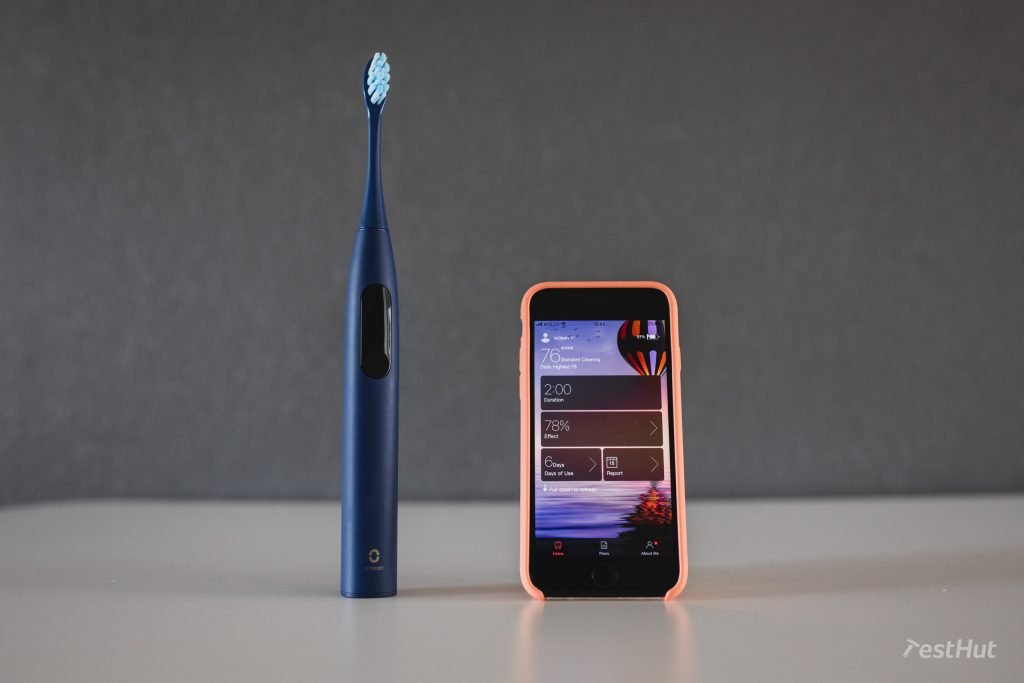
Oclean prides itself on being a tech savvy company and offering smart features for their brushes. However, we found that these features are really pretty basic.
We do like the customization options through the app, most of which you can also access using the touchscreen. You can change the brushing time and create customized programs combining any modes to create your own unique brushing experience. For gearheads, it is fun to be able to play around with the modes and intensities, but ultimately, we don’t see much practical use for this.
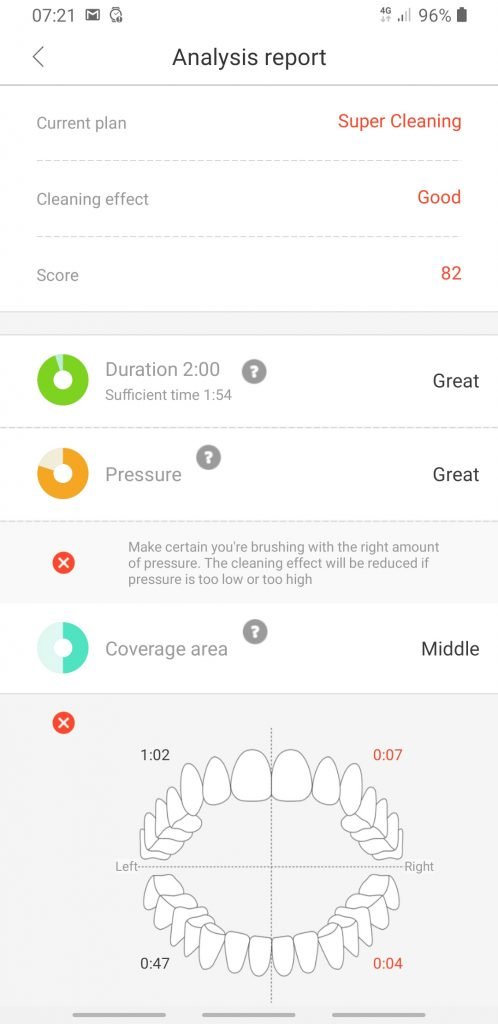
The app is easy to use and reliable, but we were disappointed with the cleaning reports. The best smart brushes have real-time brushing coaches to guide you through your routine, but the Oclean brushes give you a report only after you finish brushing telling you how you did and how to improve.
What we didn’t like
Despite Oclean’s advertising claims, the X Pro does not have a functional pressure sensor that we could detect and measure. After several tests, we were able to get the vibrations to slow down, but this took over 900 grams of force which is 3 times the recommended pressure for an electric toothbrush.
Another downside to the Oclean models is that brush heads are a bit difficult to find. There are many options available, but we could only find them online, and sometimes the colour or model we were looking for was not available. We ended up buying pink replacement brush heads for our navy blue-handled brush.
The app from Oclean does give you some brushing feedback, but we found it to be inaccurate most of the time and not useful for improving our brushing habits. We found the algorithm to be much less helpful and accurate as the live brushing coach from the DiamondClean Smart.
We like the idea of the touchscreen on the handle. We would rather have information at a quick glance rather than lugging our phone into the bathroom to access features. However, in practice, it is too small and hard to navigate to be enjoyable and practical to use right now. We hope this improves.
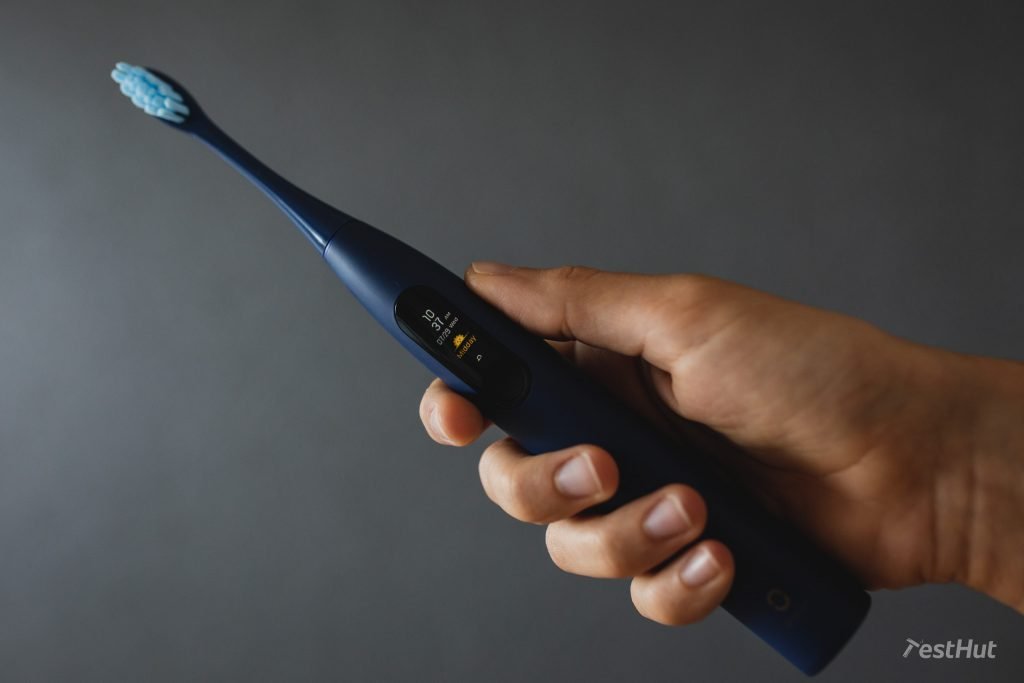
Conclusion
We think this stylish, lightweight sonic brush is an excellent travel companion with its long battery life and durable travel case. The touchscreen will also make a nice conversation starter for anyone who sees it hanging on the wall of your bathroom.
Also good electric toothbrushes
After testing, we found that most of the brushes we tested will do a fine job of cleaning your teeth. These brushes are all good enough to keep your teeth clean between dentist visits, but lacking in some areas like comfort, battery life, or ease of use.
Oral-B iO 7
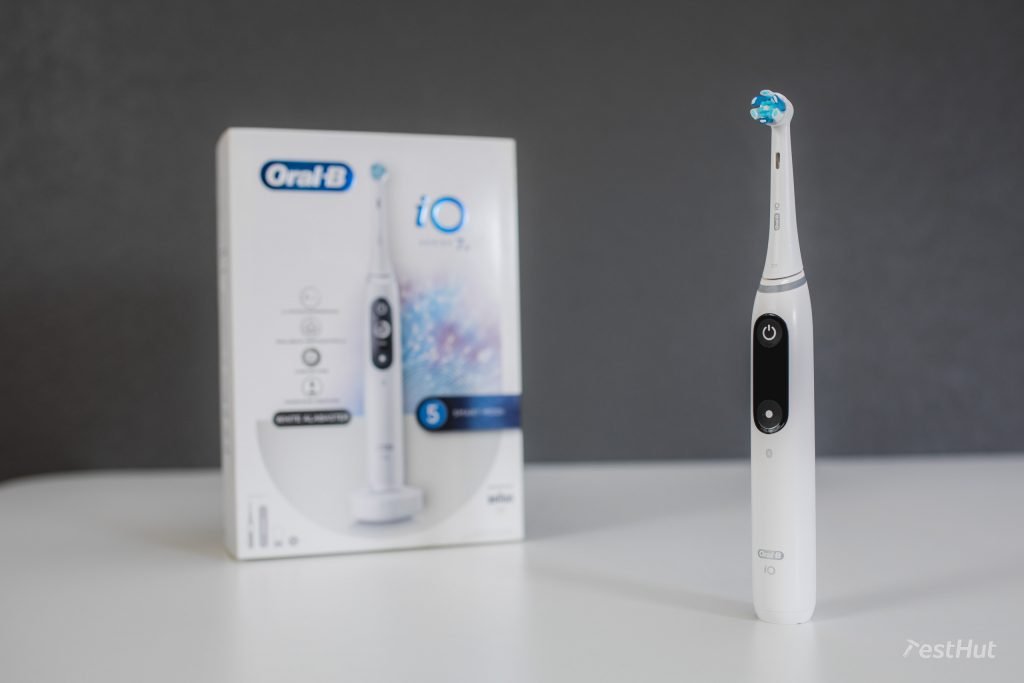
This relative newcomer (released mid 2020) was touted by Oral-B as a game changer that would revolutionize oral hygiene. But in our tests, we found it to be a good electric toothbrush, but not worth the hype or high price tag.
We bought our brush during a Black Friday sale, so we got a pretty good deal on it, and you can find discounted brushes if you take your time.
In our tests, we found that the iO 7 cleans teeth well, but the promise of the new-and-improved magnetic drive system with the futuristic brush head do not combine to greatly improve the overall cleaning experience. The new brush heads are both expensive and a bit bulky. One of our pet peeves is that the base of the brush head is cut at an angle, so they will not stand up on their own. To store them, you must use the included plastic brush holder.
The brush is more sleek and modern looking than the other Oral-Bs we tested, but the new plastic is a bit slippery when wet. It has a built-in monochrome screen that allows you to change modes and offers some basic information like brushing time.
This brush also employs a new magnetic charging system instead of standard induction. On one hand, this means a much faster charging time (3 hours in our test), but the brush’s magnets are not powerful enough to hold it steadily on the base, and the handle is prone to tipping over. Battery life is about the same as other Oral-Bs. You will get about 2 weeks of brushing time on a single charge. We found that the more we used the smart features, the less battery life we got. The iO series has some kind of motion detection, so the handle will turn on when it thinks you want to brush, and this standby mode also seems to draw a lot of energy.
The app is identical to the one we tested with the Genius X, and the brushing coach works well. We like that you can adjust brushing time from 2-4 minutes. The quadpacer is accurate and helpful, but when you use the app, it offers no guidance at all other than a clock to show you how long you have been brushing. After you finish, the coach shows a model of your teeth to show you how well you are brushing each part of your mouth.
The iO also comes with a more advanced pressure sensor which will turn green when you apply just enough pressure (at about 50 grams of force) and red when you are over brushing (about 220 grams of force).
The iO series uses a completely different brush head from the other Oral-Bs, so you only have two replacement options: Ultimate Clean and Gentle Care. As of right now, these cost about 15 pounds apiece, so using this brush will be quite expensive in the long run.
The iO is quieter than the older Oral-Bs, but not as quiet as they claim. We found it running at over 60 dB, and sometimes getting as loud as 70. It has a lower pitched hum that is more pleasant than the chainsaw-like motor of the Genius X.
We do like the iO series for the most part, but for the price, we just do not see it offering anything that makes it highly recommendable. If you want the latest, greatest offering from Oral-B and price is no option, then this might be the brush for you.
Oclean One
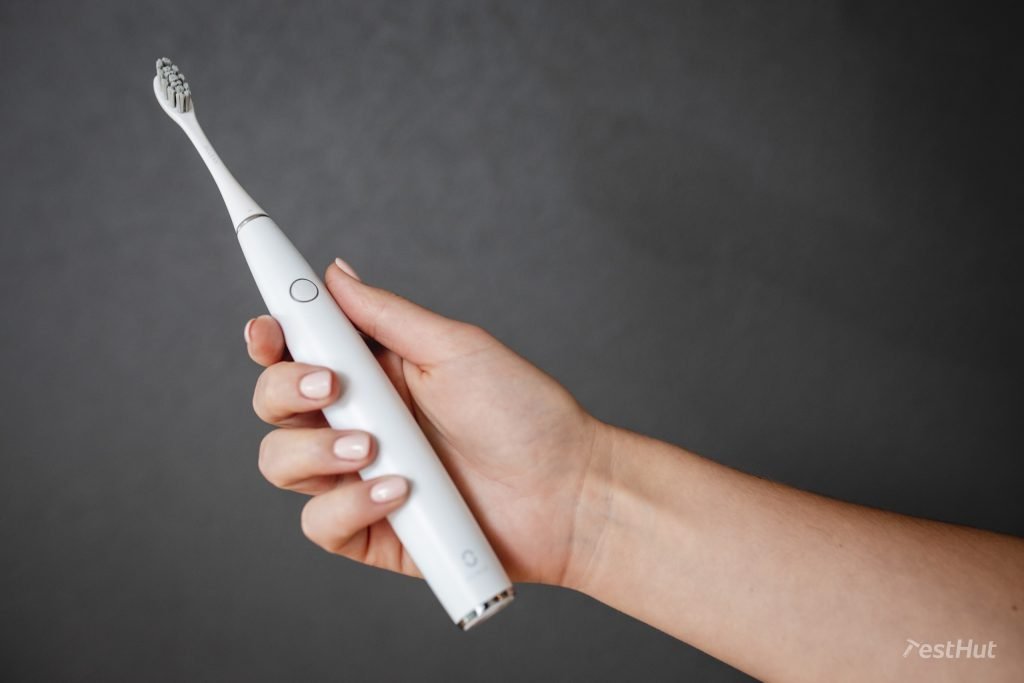
The Oclean One offers decent cleaning power in a handsome all-white package. It is solidly built, but Oclean seems to have sacrificed style for utility. The brush is prone to tip over easily and roll when set on its side, and the handle is slippery when wet.
This brush had the best battery life of any brush we tested going a full 2 months without needing a charge. And when you do need to charge it, the mag charger will fill the battery in less than 4 hours.
Update: After testing the brush for 6 months, the battery life is still around 2 months between charges.
This is also the only brush with a speaker that talks to you when you turn it on and change modes. We enjoyed it at first, but some might find it a touch annoying after a while. Luckily, you can turn the voice off with the app.
Like the X Pro, this comes with a Bluetooth connected app that allows you to create custom brushing sessions and track your brushing habits. We found that the customization features work well, but the brushing scoring and analysis are not useful. This brush does not come with a visible pressure sensor, which is a downside.
Brush heads for the Oclean are a bit hard to find, but they do offer a wide array of options when you can find them online. The single included brush head is a bit stiff, but does a nice job cleaning your teeth.
The only included accessory was a travel case which is long and bulky but would work okay in a pinch.
The brush is quiet, but the brushing experience was hindered by its single button which is not very easy to push making changing modes a painful experience. It is also a longer brush which made the cleaning process awkward.
Overall, we just felt that this brush does not clean as well as our winners, and its tendency to fall over and uncomfortable operation make it a less attractive option than its cousin, the X Pro.
Oral-B Pro 2 2000 and Oral-B Pro 3 3000
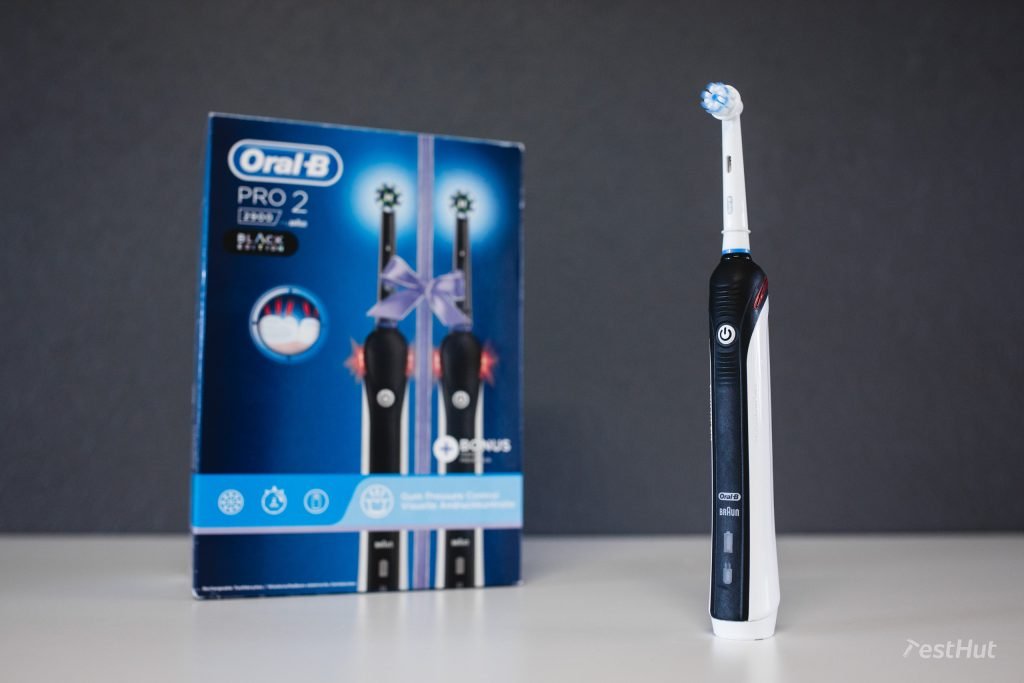
Oral-B Pro 3 3000
Oral-B Pro 2 2000
These two brushes from Oral-B are great for a low-cost every day cleaning. Both brushes offer the exact same handle albeit in different colours. In our tests, we found that these brushes clean just about as well as their much higher priced cousin, the Genius X, but for a fraction of the cost.
They do not come with many bells or whistles, but they do clean your teeth pretty well. They offer 2 cleaning modes, Daily Clean and Sensitive. The 3000 differs from the 2000 in that it offers an extra brush head and a travel case. Both brushes also come with a pressure sensor in the form of a red light on the back of the handle that lights up when you brush too hard.
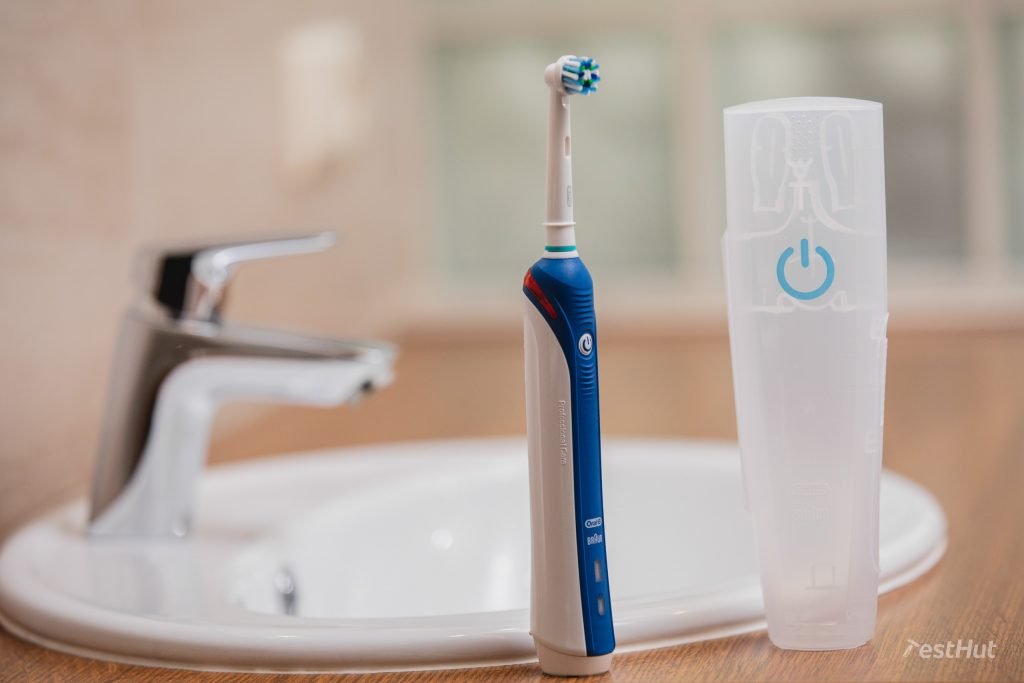
The 2-minute quad pacer helps you keep track of your brushing sessions in 30 second intervals, and the brushes will automatically keep going when time is up to allow you to really polish up any areas that need some extra attention.
Both brushes are wrapped in industrial-strength plastic, which is not beautiful, but it is very functional. They are solidly built and easy to grip.
You should get over two weeks of cleaning on a single charge from the Lithium Ion battery, which is not as good as the winning brushes. Charging time was about average taking 13 hours to charge from empty to full.
Update: After using the brush in the field for 6 months, we are getting almost exactly 14 days of brushing between charges. We have seen a slight decline in capacity over this time.
We found that these brushes were loud but powerful offering a cleaning experience that was not the most comfortable of the field. Some people like the oscillating power of Oral-B, but most of our testers preferred the comfort of the sonic brushes.
If you are looking for a decent starter electric toothbrush from one of the most trusted brands, then either of these would be a good option.
Oral-B does offer several brushes between the Pro series and the Genius X series that offer a variety of additional features. If you like the style of the Genius X, but do not want to pay such a premium, the Genius 8000 offers similar styling and app capability for about ½ the price, and the Smart 6000 is another affordable upgrade option giving you some smart features and a stylish handle and case.
Playbrush Smart One
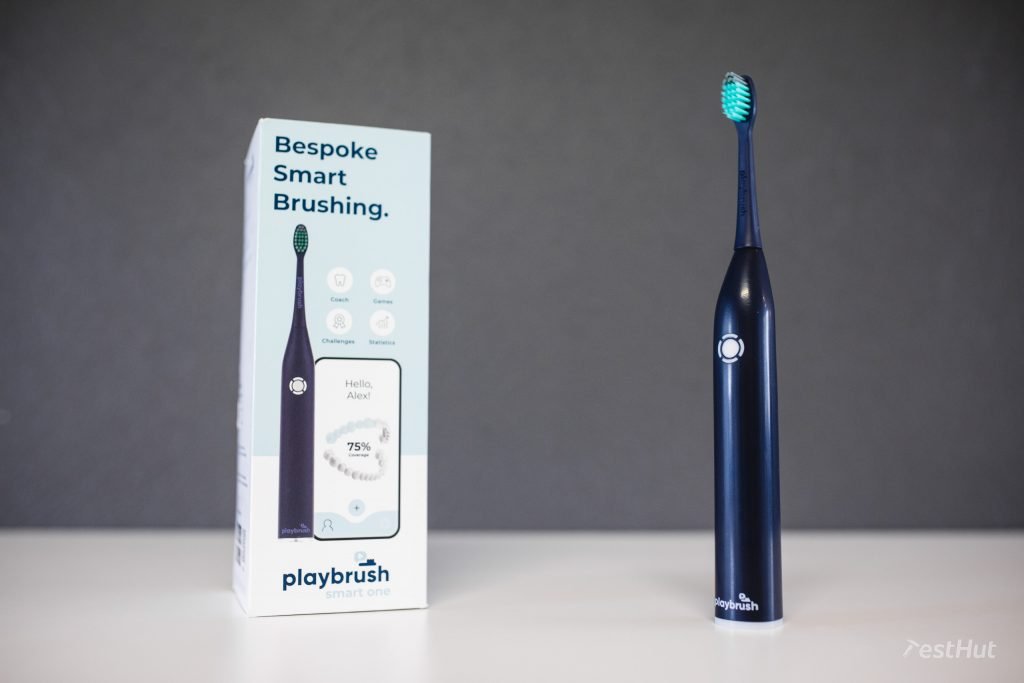
The Playbrush is a very interesting brush. We had some trouble with the first model that we tested—it wouldn’t hold a charge, and we couldn’t get some of the features to work consistently.
After a few emails, Playbrush customer service was excellent, and they sent us a replacement brush which seems to be working better.
This is one of the lowest cost smart brushes that offers a real-time brushing coach. The app is fun and easy to use, but to get the full features, there is a subscription cost. The app also tracks your brushing habits, scoring you each time you brush and storing the information so you can see how well you are doing. We like the music that plays as you brush and the little news updates you get on the screen, but the motion tracking is not as sophisticated as the Genius X.
They also offer a subscription program for replacement brush heads. You can purchase a quarterly or annual subscription, but it isn’t required to use the brush.
The Playbrush was the most powerful sonic brush we tested. It did not do the best in our plaque removal home testing, but it excelled at our lab tests. One downside is that it does not have a working pressure sensor. They claim that it does, but in our tests we could only get the motion detection to work.
It is easy to use with just one button and a quadpacer that helps you get your whole mouth clean. It is a bit loud, and the power of the brush can be a bit uncomfortable for those with sensitive teeth or gums.
It offers 3 modes via the app, so you can try the sensitive mode if the clean mode is too much. Playbrush only has one brush head available, so there is no sensitive option.
It comes with a stick-on phone holder so you can watch the app as you brush your teeth in the morning hands-free. We found this to be quite useful. However, there is no travel case available for the Playbrush.
The battery life is average giving you about 18 days of cleaning between charges. Charging times, however, were sporadic because we had a faulty brush and/or charger, we still are not 100% certain, but it took us 2-3 full days to go from an empty battery to full in our home test.
Although the brush gave us some issues during testing, the replacement model seems to be holding up well, and it offers a lot of cleaning power for a decent price.
Update: After 6 months, we are still seeing sporadic charging results. If the brush runs out of power completely, it can take up to 48 hours to fully charge again. We got the best results if we charged as soon as the battery icon turned red on the app. When charging from red to full, it took about 8 hours.
Xiaomi Mi
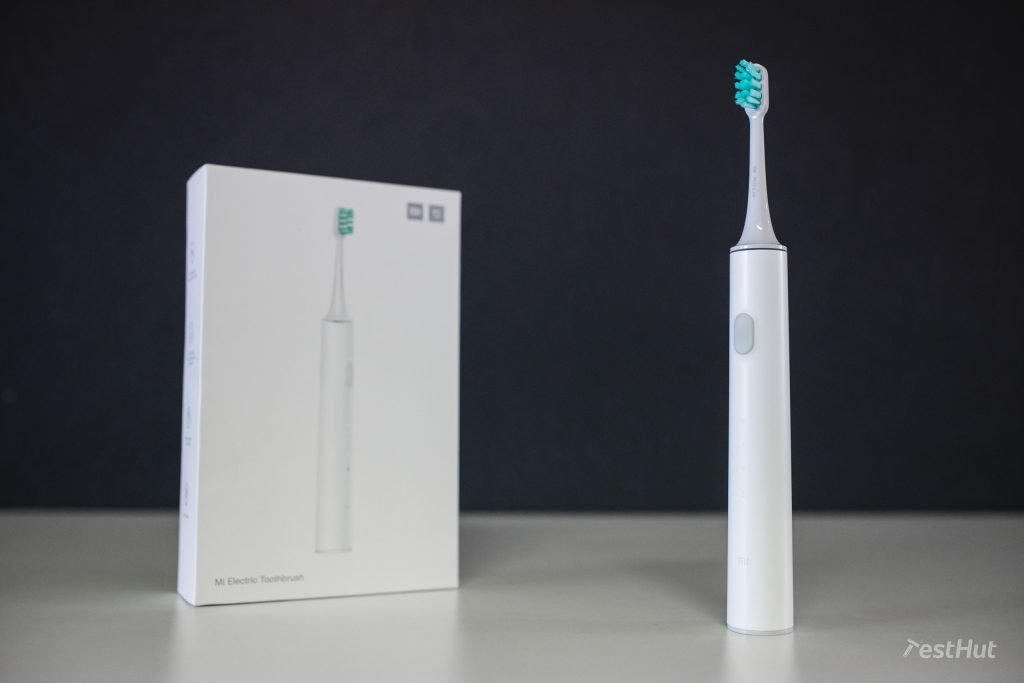
The Xiaomi Mi brush was the cheapest brush we tested, but it still performed well overall.
It only comes with one brush head and no travel case, but you do get the Xiaomi Home app and a Bluetooth connection to track your brushing habits and offer some customization.
The brush cleans pretty well, performing above average in both our plaque and lab tests.
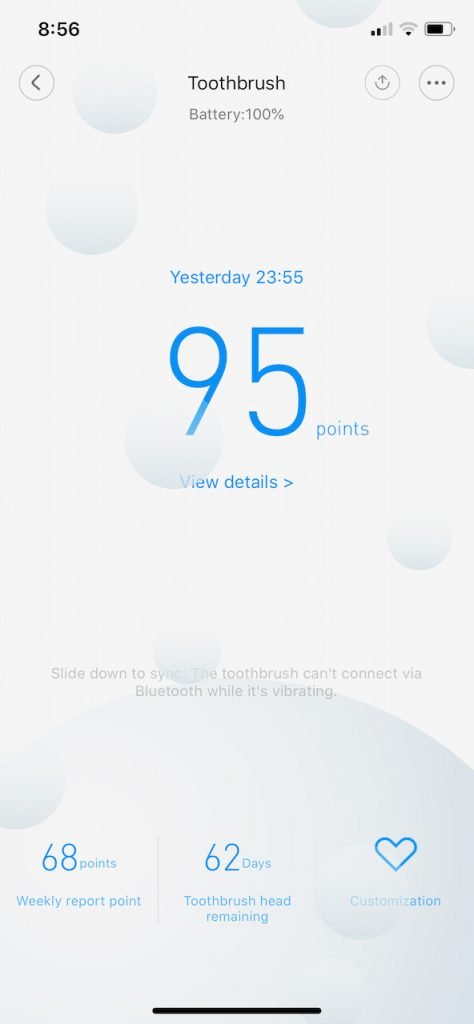
Styling is very simple in an all-white plastic handle with grey accents. A single button controls the brush, and we didn’t like that the modes were not labelled at all.
Battery life was a disappointing 10 days, the lowest of any brush we tested. Charging took about 9 hours.
Update: After testing the brush for 6 months, the battery life is still 10 days between charges.
This was the quietest brush we tested, and we found it easy and comfortable to use. One small downside was that the brush head is surrounded by brittle plastic that had a tendency to bump into our teeth.
The brush does not have a pressure sensor, but the quadpacer is very accurate and will guide your brushing sessions to perfection.
We think the Mi is a decent brush at a very good price point.
Brushes we don’t recommend
After researching electric toothbrushes, and narrowing down our top picks, we had high hopes for all the models that we tested. However, when it came right down to it, some brushes just did not clean as well as others, and we found that two of our choices consistently underperformed in both our lab tests and plaque tests. We cannot recommend these two under any circumstances.
Furthermore, we would be very cautious to order any of the off-brand discount models that are so common on Amazon and other websites. In our research, these brushes seem to be cast from the same generic mould using the same parts under different names with different skins and features. To get a quality cleaning, we recommend purchasing from a respected company with proven effectiveness.
Atmoko
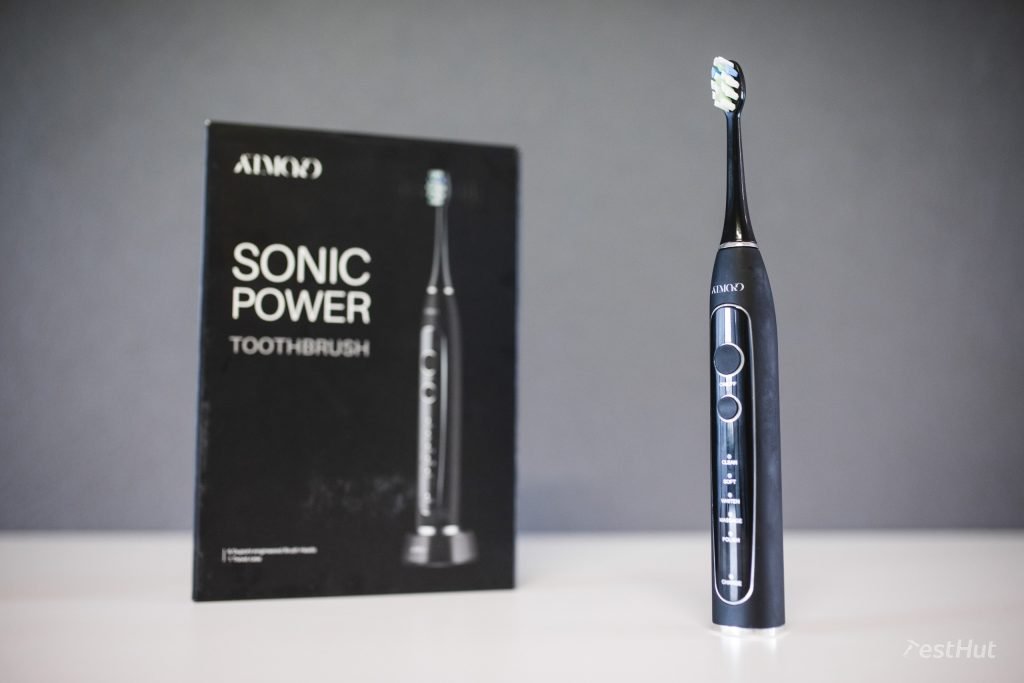
We chose the Atmoko because there are about a hundred Chinese-made off-brand brushes that you can buy, but this one came with most of the features we were looking for in a sonic brush along with 6 brush heads, a travel case, and 5 cleaning modes.
However, the retro-styled Atmoko did not do well in the most important test—cleaning. We found that the power and motion of the brush did not do much to get our teeth clean. It did poorly in both our home plaque test and the lab cleaning tests. All of the testers felt this brush was underpowered and that it really wasn’t doing much cleaning at all.
It also comes with just one type of brush head, and we found it to be a little stiff. We would like to see more brush head options. It does come with a functional travel case.
All told, we liked the look and feel of this brush, and it was easy to use; but because it does not offer any real cleaning benefits, we cannot recommend it.
Fairywill P11
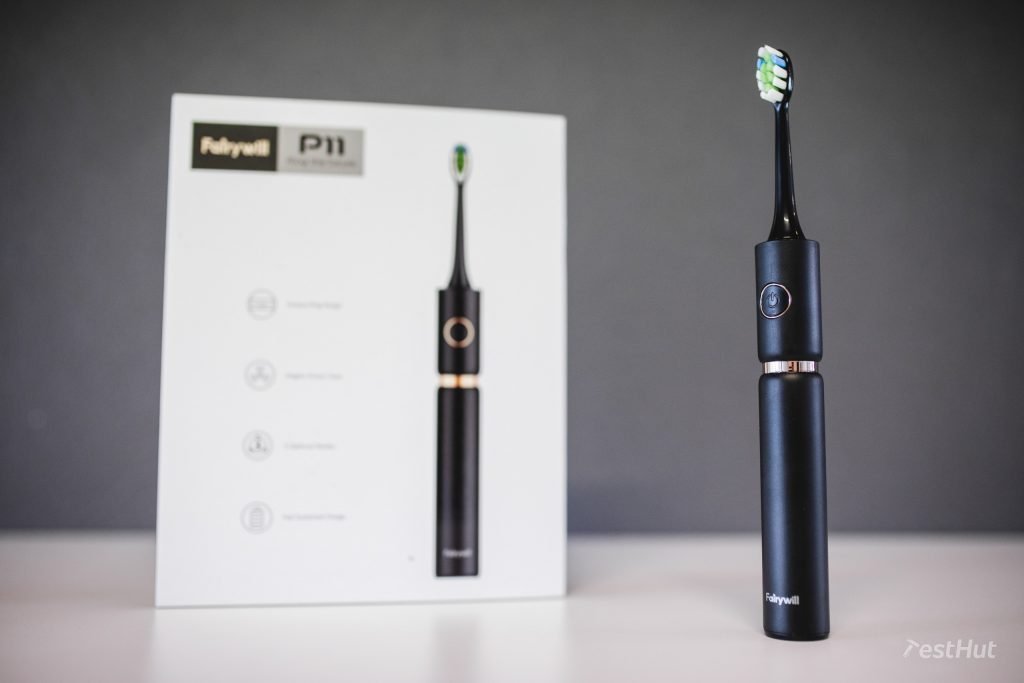
The Fairywill P11 has many sterling reviews on Amazon, and the language used to describe the features makes it seem like an amazing brush. But when we actually ordered it and tested it, we saw the truth, and it let us down big time!
The brush was ultimately the lowest rated brush that we tested. There wasn’t much to like about it other than the stylish box that it came in.
The main problem with the brush is that it just doesn’t clean well at all. No matter what mode you use, you will just find that this brush offers very little power. It did poorly in both the plaque tests and lab tests, and none of the testers felt that their teeth were clean after using this brush.
It did come with a travel case, but it is also the strangest case that we tested. Instead of opening and closing with a lid and latch like the other cases, this one splits in half and wraps around the brush. We kind of liked it until we found that the fit was so tight that it actually scratched the brush handle when we used it.
This kind of poor design is indicative of the Fairywill brand.
We would not recommend this brush under any circumstances when there are brushes that actually clean your teeth well for roughly the same price. Don’t be fooled by clever marketing!
Electric toothbrush research
Before we even started, all of our testers had been using electric toothbrushes for a few years, so we were already pretty familiar with the niche. But to get up to speed with all the newest products and technologies we had to take a deep dive in the expansive electric toothbrush market.
We wanted to know what real product owners look for in a good electric toothbrush, so our team analysed literally thousands of user reviews on the largest e-commerce platforms across Europe, including Amazon. Plus, we researched the work of the most trustable testing websites around the world such as Wirecutter, Which, Test.de, and many others. In addition, we consumed professional reviews on websites like Electric Teeth. Then we visited and surveyed actual dentists and hygienists to get their professional opinions about electric toothbrushes.
As a result, we understood that a great electric toothbrush should:
- have effective cleaning power,
- be comfortable and easy to use,
- include a long-lasting lithium-ion rechargeable battery,
- have a precise quadpacer and 2-minute timer,
- have a variety of available replaceable brush heads,
- include a visible pressure sensor,
- be reliable and durable.
Product filtering
One of our priorities here at TestHut is to make sure we don’t miss any good products when we perform our tests. In our initial research, we dug deep to find over 200 electric toothbrushes on the market, which is way too many to test. So we used a focused approach to filter products in four stages to select brushes worth buying and testing.
Here is a short version of how we went from over 200 products to 12 candidates for testing.
First we got rid of products that didn’t have the features that are crucial for a good electric toothbrush based on the list above.
Then we eliminated products that came from sketchy brands and low-rated products that were prone to failure or malfunction.
Next we broke down the product lines of the large brands, such as Oral-B and Philips Sonicare. Going through all those seemingly random model numbers was like trying to dig a coal mine with a spoon, but eventually most of the confusion became clear. In the end, we decided to test the top-of-the-line flagship models to learn about the best features these brands offer, as well as the mid-range products that offer great cleaning performance at a reasonable price.
In the last filtering round we performed an in-depth product analysis for each of the last 20 models that had made it this far. This meant digging up any bits of information we could find in practically any language, country or search engine.
After a month of research and careful deliberation we chose 12 of the best brushes on the market to purchase and test for ourselves, so we could bring you our unbiased and reliable verdict.
How we tested electric toothbrushes
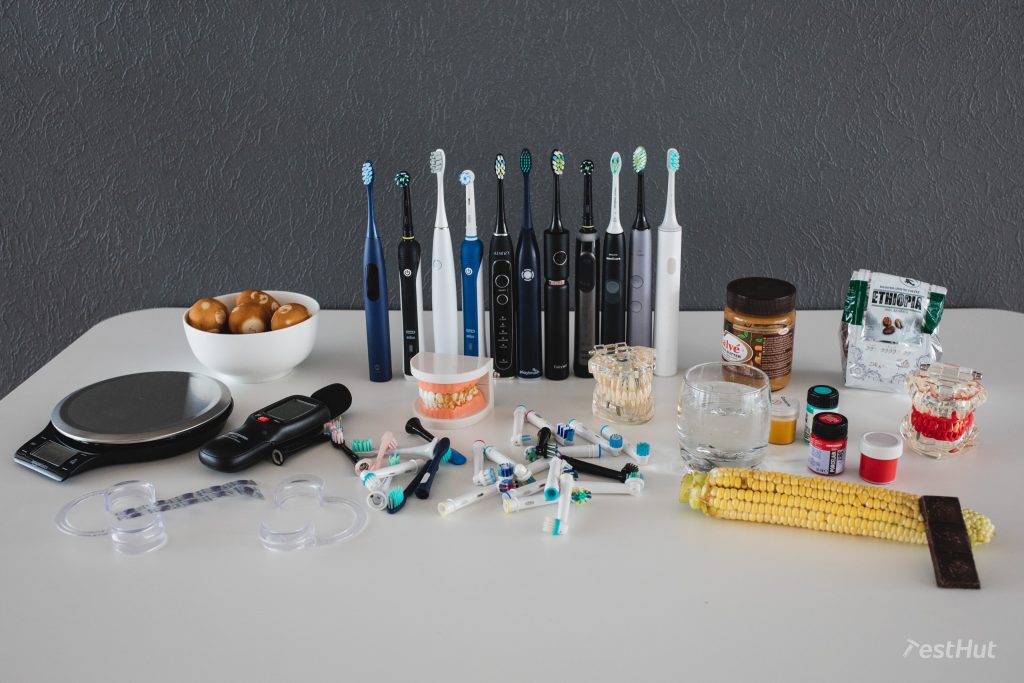
Before the best brush candidates arrived at our lab, the TestHut team spent hours learning how to test brushes for effectiveness. We read professional medical testimony about how to set up proper tests. We talked to dentists and other oral care professionals. We watched countless YouTube videos and read several articles about how people test electric toothbrushes.
From all this we decided that the best way to really know how well a toothbrush works is by performing both home and lab tests.
Once we all finished testing each brush, which took almost 2 months, we rated and ranked brushes based on the features they offered and how well they cleaned. Then we deliberated together and came to conclusions about each brush to give each one final scores that we could all agree on.
How we scored electric toothbrushes
We used the following criteria for our final ratings:
- Cleaning Performance (40%): How well the brush cleaned in both plaque tests and lab tests;
- Comfort (25%): How pleasant and easy the brush is to use;
- Features (10%): The included features—such as the quadpacer and pressure sensor—and how well they are implemented;
- Build Quality and Design (10%): The overall look and quality of the brush;
- Battery life and Charging (10%): How long the battery lasts and how long it takes to charge;
- Box Contents (5%): Included brush heads and accessories like a travel case.
| Toothbrush | OVERALL SCORE | Cleaning performance (40%) | Comfort (25%) | Features (10%) | Build quality and design (10%) | Battery life and charging (10%) | Box contents (5%) |
|---|---|---|---|---|---|---|---|
| Philips DiamondClean Smart | 4.4 | 4.3 | 4.5 | 5.0 | 4.7 | 4.3 | 4.7 |
| Philips Sonicare 4300 | 4.4 | 4.8 | 4.4 | 3.9 | 5.0 | 4.3 | 1.8 |
| Oral-B Genius X | 4.2 | 4.3 | 4.2 | 5.0 | 4.4 | 3.4 | 3.8 |
| Oclean X Pro | 4.1 | 4.3 | 4.3 | 3.6 | 4.6 | 3.7 | 3.5 |
| Oclean One | 3.9 | 4.3 | 3.2 | 3.0 | 4.8 | 4.6 | 2.5 |
| Oral-B iO 7 | 3.8 | 4.3 | 3.1 | 4.7 | 4.9 | 2.1 | 3.5 |
| Oral-B Pro 3000 | 3.8 | 4.3 | 3.6 | 3.7 | 4.2 | 2.8 | 2.7 |
| Oral-B Pro 2000 | 3.7 | 4.3 | 3.6 | 3.7 | 4.3 | 2.8 | 0.8 |
| PlayBrush | 3.7 | 4.5 | 3.6 | 2.9 | 4.4 | 2.2 | 1.6 |
| Xiaomi Mi | 3.4 | 3.3 | 4.1 | 3.6 | 4.3 | 2.0 | 1.8 |
| Atmoko | 2.9 | 2.3 | 3.3 | 2.7 | 4.2 | 3.5 | 2.5 |
| Fairywill P11 | 2.4 | 1.5 | 2.8 | 2.0 | 3.9 | 4.3 | 2.5 |
Smart features were not included in the final scores for choosing the best overall brush since not all of the brushes we tested were smart toothbrushes.
We used a 1-5 rating system and the top 5 brushes all earned overall ratings of at least 4 out of 5. The next 5 brushes scored over 3, and the 2 brushes we cannot recommend did not reach 3 out of 5.
How we tested: Cleaning performance
At TestHut, when we test, we focus on the one job that the product was designed to do. We believe that the most important thing an electric toothbrush can do is to clean your teeth, so that was the main focus of our testing and 40% of the total score.
To gauge cleaning performance we started with home testing, tracking how clean our teeth felt during and after each brush, and how long this fresh feeling lasted during the day. Some brushes gave us that “after the dentist” clean feeling, while others left us wanting to brush again immediately after finishing.
After several days of regular brushing, to get more objective results, we started using plaque revealing pills. These pills coat the plaque on your teeth in a pink colour so you can see where the brush has cleaned, and, more important, where it has not. When plaque is left on your teeth, the bacteria secrete enamel eating substances that lead to tooth decay. After brushing, we took photos of our teeth so we could compare the results from all the brushes in our test side by side.

We repeated this test several times, and even scored photos without knowing which brush was used to make sure that our results were unbiased.
After the home testing phase was complete, we took all the brushes to our TestHut lab and assessed raw cleaning power. We cleaned coffee grounds off of corncobs, we scrubbed peanut butter, beetroot juice, and chocolate off of fake teeth. Then we scrubbed stained eggs until they were white again to see how different brush heads performed. Through all this we found out which brushes were the most powerful.
For the corncob test, we filled a fresh ear of corn with Columbian coffee grounds and then ran each toothbrush over the cob to see which one could remove the most grounds in a single pass. We were impressed at how clearly this test showed which brushes had some real cleaning power versus those that vibrated, but really weren’t doing much. The top brushes in our plaque reveal pill tests were also very good at removing the coffee grounds. We could see that the same brushes that struggled with interdental cleaning in our plaque tests also struggled to remove grounds stuck between the kernels.
To determine why some brushes performed better, we took super slow-motion videos of them in action to see the difference in the amplitude modulation. What we saw was that all the brushes vibrate at high speeds, but some brushes are clearly moving a greater distance with each vibration than others, and this seems to correlate with more cleaning power and better overall cleaning ability.
Cleaning performance results
To determine overall cleaning performance, we rated each brush in 3 subcategories: Feel after cleaning, plaque removal, and power. The plaque test gave us the most objective and useful results, so we weighted this at 50% for the category.
We weighted feel after cleaning and power at 25% each because they are important, but not as essential as plaque removal.
| Toothbrush | CATEGORY OVERALL | Plaque removal (50%) | Feel after cleaning (25%) | Power and amplitude (25%) |
|---|---|---|---|---|
| Philips Sonicare 4300 | 4.8 | 5 | 5 | 4 |
| PlayBrush | 4.5 | 4 | 5 | 5 |
| Philips DiamondClean Smart | 4.3 | 4 | 5 | 4 |
| Oral-B Genius X | 4.3 | 4 | 5 | 4 |
| Oclean X Pro | 4.3 | 4 | 5 | 4 |
| Oral-B iO7 | 4.3 | 4 | 5 | 4 |
| Oclean One | 4.3 | 4 | 5 | 4 |
| Oral-B Pro 3000 | 4.3 | 4 | 5 | 4 |
| Oral-B Pro 2000 | 4.3 | 4 | 5 | 4 |
| Xiaomi Mi | 3.3 | 3 | 4 | 3 |
| Atmoko | 2.3 | 2 | 3 | 2 |
| Fairywill P11 | 1.5 | 1 | 2 | 2 |
The Sonicare 4300 performed very well in all three categories, always scoring in the top 3 spots. It was closely followed by the Playbrush Smart One. While the Playbrush was the most powerful in our lab tests, it couldn’t quite keep up with the 4300 in plaque tests. This shows that raw cleaning power doesn’t necessarily result in better cleaning performance. We think that the quality of brush heads also plays a role in this, and the Sonicares have some of the best brush heads out there.
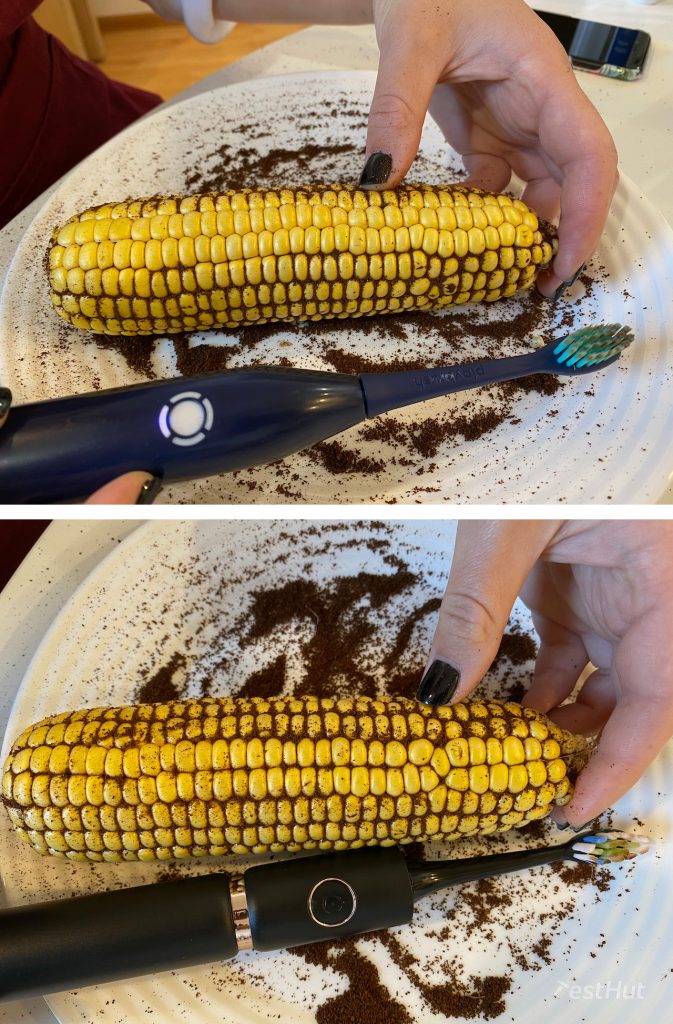
Unlike all the other sonic toothbrushes we tested, the 4300 and DiamondClean seem to skate around the mouth as if they are floating on a layer of foaming toothpaste that cleans all around the teeth. No other brushes gave us this sensation. In addition, the Sonicare brushes were the only ones which were angled like dental instruments, and we think this allows them to clean more thoroughly with less effort, especially in the hard-to-reach areas.
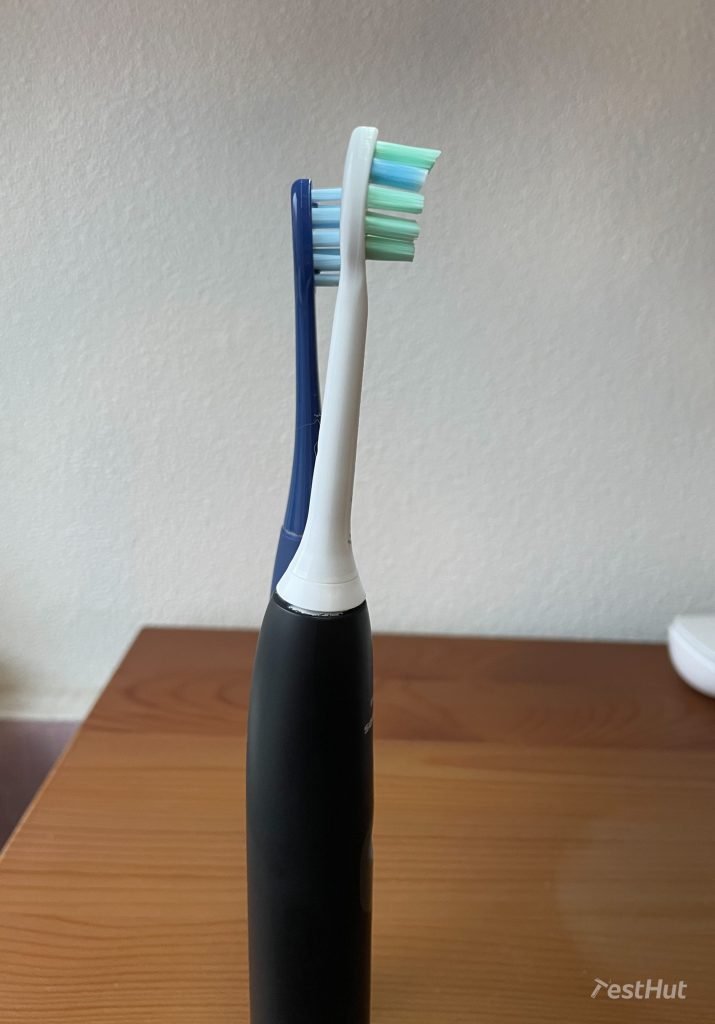
It was surprising that the DiamondClean lost to the much less expensive 4300 because, on paper, they both have the same cleaning technology. We contacted Philips about this, and this is what they said: “All Sonicare toothbrushes use the same ‘special technology’, which ensures high-frequency movements. Both brushes have the same speed.”
The only difference was that we used the newest C3 brush heads on DiamondClean and an older C2 with the 4300. The C2 brush heads are smaller in size, so it’s easier to clean hard to reach areas. We think that this might be why it outperformed the DiamondClean in our plaque tests.
All of the Oral-Bs and both Ocleans showed similar results in lab and plaque tests finishing close to the winners. These brushes all provide a great cleaning experience, but they were not quite at the level of the Sonicares.
Further down the list, the Xiaomi lost points in both the plaque and lab tests. While it has less power than the top brushes, it actually still produced acceptable cleaning results, and was still way ahead of Atmoko and Fairywill in all the tests. While it wasn’t one of the top performers, we think it cleans well enough to recommend it.
Neither the Atmoko nor Fairywill performed acceptably in our cleaning tests. When we took them home, none of us were happy with the experience, and some of us even supplemented cleanings with our own brushes. The lab tests confirmed our results by showing that these brushes barely moved the coffee grounds, and in slow motion tests we could see the brushes vibrate, but they do not have much modulation at all. And in our plaque tests, these two brushes always left the most plaque. We cannot recommend them for this reason.
How we tested: Comfort
When you buy an intimate personal appliance like an electric toothbrush, you want to feel comfortable using it day in and day out. After all, if you are a steady brusher, you are going to have this in your hands for at least 4 minutes each and every day. This category was 25% of the total score.
Comfort is all about how good the brush feels and how easy it is to use. We broke down overall comfort into several subcategories. Many of these were rated subjectively while we tested the brushes at home, and then calibrated and adjusted after collaboration.
To measure feel while cleaning, we brushed with each model several times making notes about how it felt in our hands and in our mouths. The lowest scores for comfort were given to those brushes which felt like they were not cleaning at all, while other brushes lost points for causing discomfort or pain because of their aggressive brushing action. The best brushes cleaned very well with no noticeable discomfort.
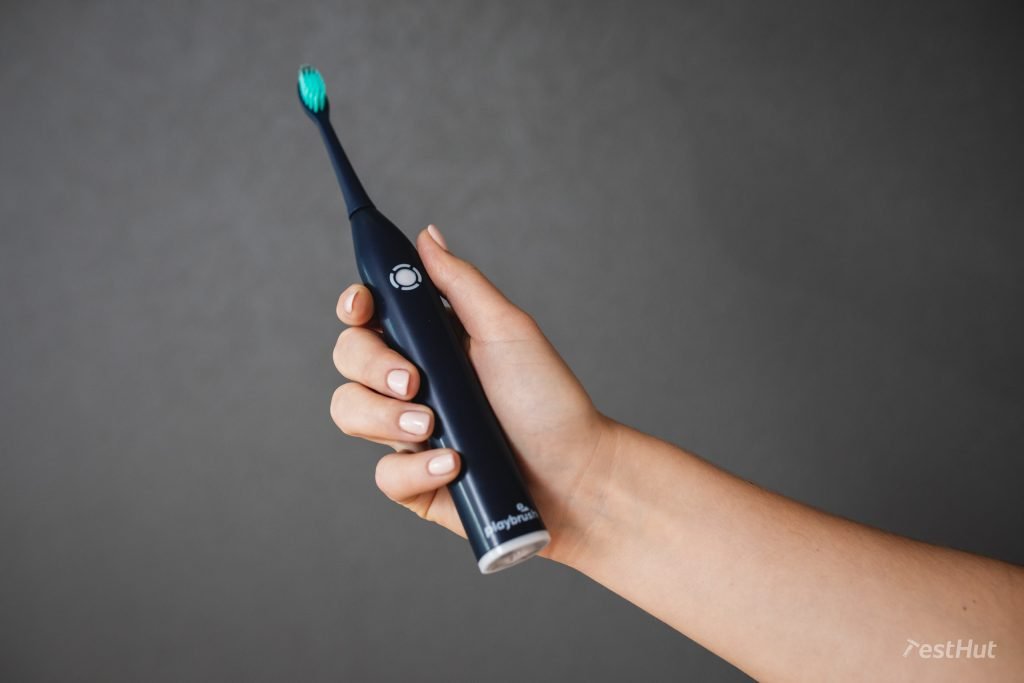
For grip, we focused mainly on the idea that you don’t want to drop the brush when you are using it, so we performed wet and dry grip tests. Slippery handles were downgraded.
Then we tested how easy the brush was to start and stop. The easiest brushes took a simple single push of the button, while other brushes required holding down the button or going through all modes which entailed unnecessary effort.
We tested loudness with a decibel meter 10 cm away from the brush handle while it was running. We tested each brush several times, changing modes and positions to get the most accurate readings.
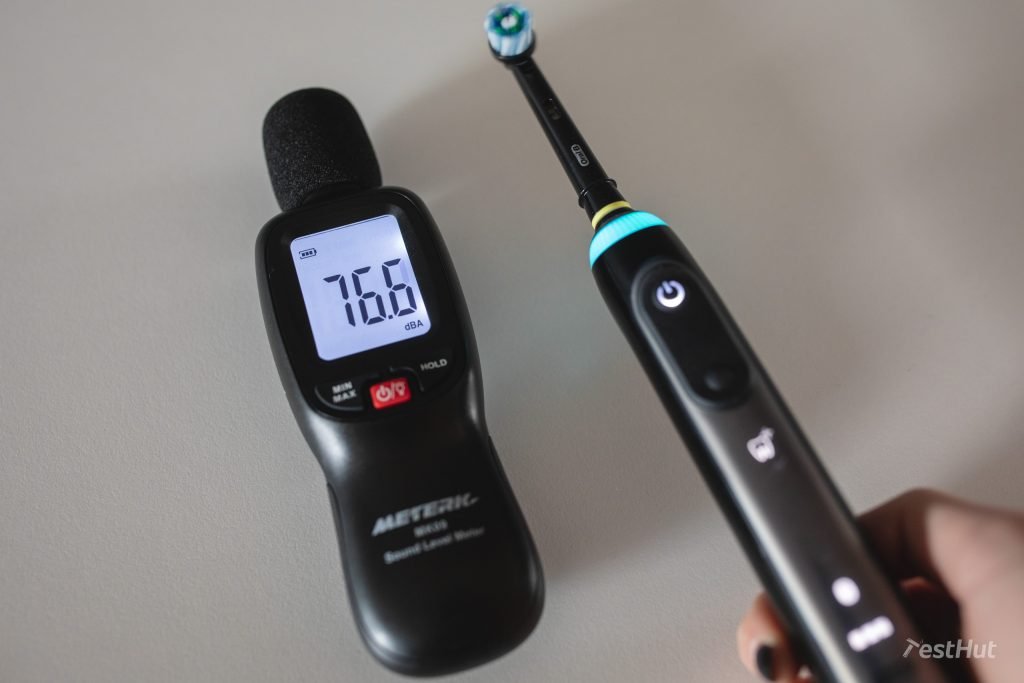
Most of us keep our electric toothbrushes standing upright on the sink, and the last thing we want is a wobbly handle that will tip over and fall to the floor at the slightest tremor. The stability test was our “earthquake” test, where we lined the toothbrushes up on the table, and then shook the table to see which ones fell down first. We also checked to see which brushes rolled when landing on their sides.
Another feature of comfort is having many brush head options available. Different people have different teeth and may find one brush head more comfortable than another. One obvious example are softer bristles for sensitive teeth. But there are also special brush heads for braces and compact heads for smaller mouths. We gave the highest scores to those manufacturers with many options and low scores to those with only one option.
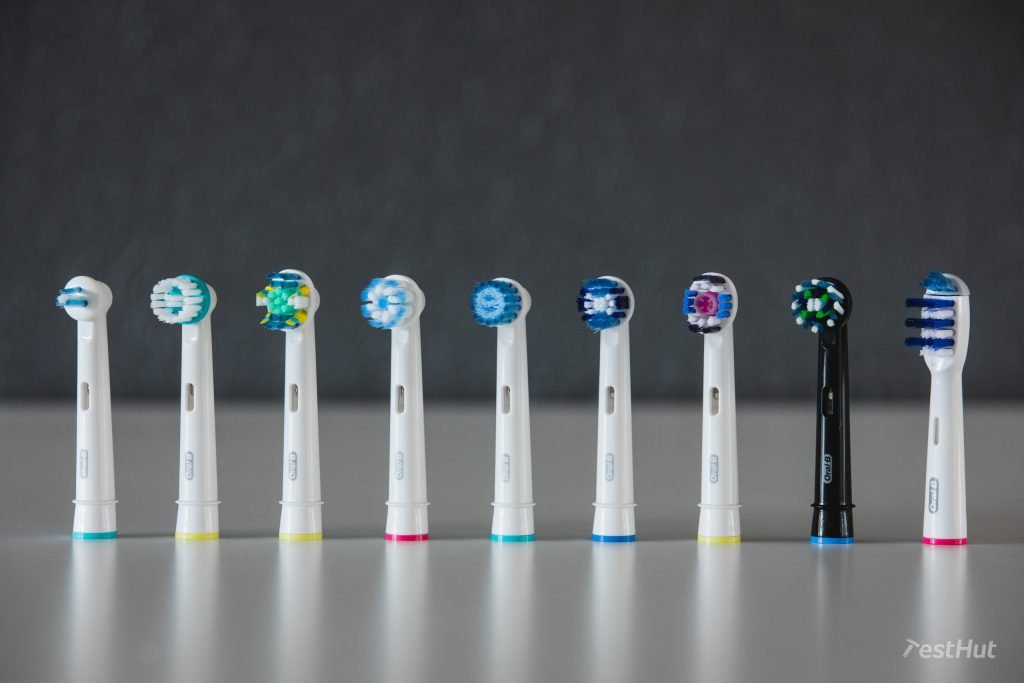
The next subcategory is ease of mode switching and Indication. Some of the brushes were intuitive and simple to operate while others were more complicated and did not label the modes clearly.
Then we tested the button placement to see how easy and comfortable the buttons were to locate and push without looking.
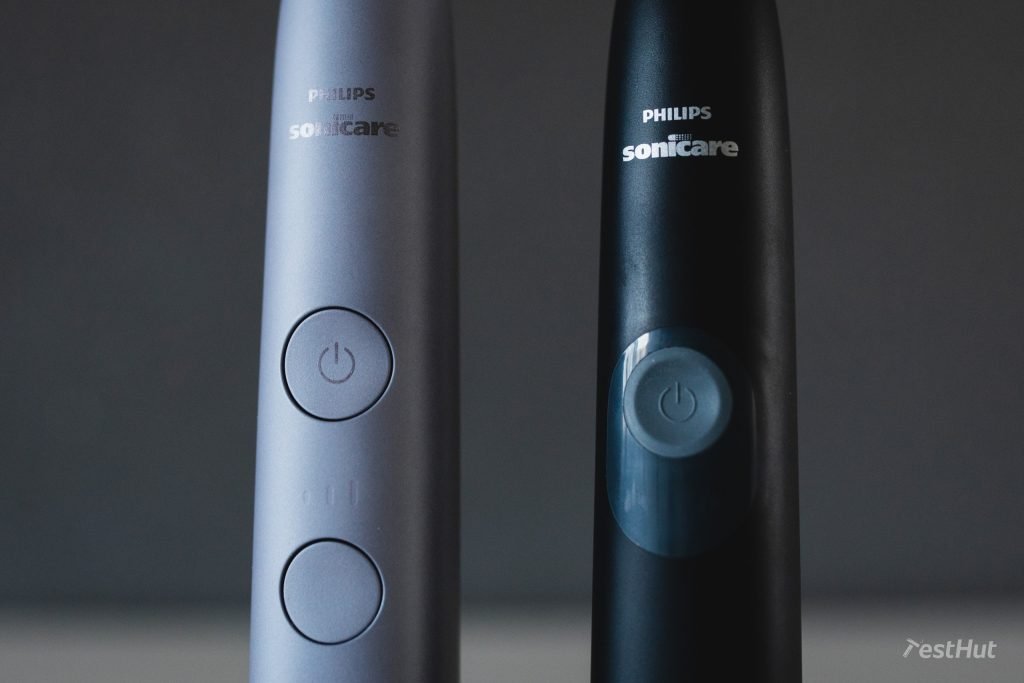
Finally, we scored each brush based on how easy it was to maintain and keep clean.
Comfort results
Feel while cleaning is the most important of these subcategories, so we weighed it at 25% followed closely by the in-hand feel at 20%.
Startup/shutdown, loudness, storage stability, and brush head options were all worth 10%.
The less important aspects of comfort included mode switching, button placement, and cleaning the handle all at 5%.
| Toothbrush | CATEGORY OVERALL | Feel while cleaning (25%) | Grip and in-hand feel (20%) | Startup, shutdown (10%) | Loudness (10%) | Storage, stability (10%) | Brush head choices (10%) | Mode switching and indication (5%) | Button placement (5%) | Cleaning the handle (5%) |
|---|---|---|---|---|---|---|---|---|---|---|
| Philips DiamondClean Smart | 4.5 | 5 | 4 | 5 | 3 | 5 | 5 | 4 | 4 | 4 |
| Philips Sonicare 4300 | 4.4 | 5 | 4 | 4 | 3 | 5 | 5 | 3 | 4 | 5 |
| Oclean X Pro | 4.3 | 5 | 4 | 4 | 3 | 5 | 4 | 3 | 4 | 5 |
| Oral-B Genius X | 4.2 | 4 | 5 | 5 | 1 | 5 | 5 | 3 | 5 | 3 |
| Xiaomi Mi | 4.1 | 4 | 4 | 4 | 5 | 4 | 3 | 4 | 4 | 5 |
| Oral-B Pro 3000 | 3.6 | 4 | 4 | 4 | 1 | 3 | 5 | 3 | 3 | 4 |
| Oral-B Pro 2000 | 3.6 | 4 | 4 | 4 | 1 | 3 | 5 | 3 | 3 | 4 |
| PlayBrush | 3.6 | 4 | 4 | 5 | 2 | 5 | 1 | 2 | 3 | 5 |
| Atmoko | 3.3 | 2 | 4 | 5 | 3 | 4 | 1 | 5 | 5 | 3 |
| Oclean One | 3.2 | 4 | 2 | 3 | 4 | 1 | 5 | 2 | 3 | 5 |
| Oral-B iO 7 | 3.1 | 3 | 3 | 4 | 2 | 2 | 2 | 5 | 5 | 4 |
| Fairywill P11 | 2.8 | 2 | 3 | 4 | 4 | 3 | 1 | 3 | 3 | 4 |
The top brush in this category was the impressive DiamondClean Smart which was comfortable, simple to use, and extremely stable. All the testers agreed that it was a pleasure to brush with and operate. It also won our earthquake test in 3 separate trials. While not the quietest brush at 62 dB, it was not loud enough to be annoying. It did lose a point for mode switching because you can only change intensities while the brush is running, but you have to shut it off to switch modes. We also felt that in the long term there could be issues with cleaning between the button’s nooks and crannies.
The Sonicare 4300 and Oclean X Pro were almost evenly matched. They are both easy to operate and offer comfortable brushing. They lost points because the modes are not clearly labelled on the handles nor do they have a dedicated button for mode switching. The X Pro has a touchscreen which you might think would make it easier to operate, but it is not very responsive. It lost a point for brush head choices, and another for requiring 2 button presses to start the cleaning session.
Next was the Genius X which scored well, losing the most points because of its loud operating volume; at 72 dB it was the loudest brush we tested (together with the Pro 2000 and 3000), almost as loud as a vacuum cleaner. The oscillating power also made it less comfortable to clean with than our top scorers, especially for those with sensitive teeth and gums. On the plus side, it has the best grip and in-hand feel of any brush we used. It also has a wide array of available brush heads. It lost points for mode switching because you have to turn the brush on in order to switch modes. We also found that keeping all the rubberized surfaces clean from toothpaste grime is a challenge.

Scoring just above a 4 was the Xiaomi Mi, which was both easy to operate and the quietest brush in the test at just 55 dB. It lost a point for comfort because the square shape of the brush head makes it harder to get to the back of the mouth, and the plastic edges of the brush head would sometimes make contact with teeth. The mode indicator lights on the handle are not clearly labelled, and it has a limited number of brush heads which are only available online.
The Oral-B 2000 and 3000 are basically the same brush, so they tied, losing points for being very loud at 73 dB. They were also more prone to fall over than other brushes because of their narrow bases. To switch modes, you have to hold the single button down, and there is no indicator on the handle. Though not quite as powerful as the Genius X, these brushes still caused some discomfort while cleaning. Because these are Oral-B brushes, they got high points for brush head availability.
The Playbrush scored the same as the Oral-Bs, losing points for being pretty loud at 66 dB and earning just 1 poing for brush heads because it only has one option available. To switch modes, we had to use the app on our phone, and there is no indicator on the handle at all. The brush was relatively comfortable to clean with, although the powerful cleaning action was a bit harsh for some users.
Next came the Atmoko with its anaemic cleaning action, earning just 2 points for feel while cleaning. It did well in most other categories, but also lost out because of only one available brush head. The one bright spot for Atmoko was the ease of the two-button mode switching operation with very clearly marked modes on the handle.
The Oclean One was a disappointment because we thought the brush would do better. However, the slick handle, and unstable base make it impractical for daily use. In fact, this was the only brush that we had to fight to keep it from falling out of our hands when it got wet. And no brush fell over as often as this one. Not only is it prone to fall, but it has nothing to keep it from rolling once it hits the floor, so we labelled this one as “most likely to get lost under your bathroom cabinets.” One of its worst features is the mode switching operation which forced us to hold the single button down for 2 full seconds to get from one mode to the next, and they are not clearly marked but just labelled by single lights, so it was very hard to tell what mode we were in.
The Oral-B iO 7 scored surprisingly low in this category. First of all, it is a pretty loud brush despite Oral-B’s attempts to make it quieter. A few things make it a less than enjoyable brush to use daily including the slick handle and large brush heads. One big issue we had was that the tapered brush heads force your mouth open when you brush your back teeth meaning that foam and paste ooze out as you brush making for a messy cleaning experience. In addition, the cleaning experience is still harsh, and they only offer two brush head options.
Finally, the Fairywill scored the lowest of all brushes. When you brush, the vibration is so weak that it feels like there is no cleaning going on, so you end up brushing like a manual toothbrush making it uncomfortable to clean with. In addition, it offers just one standard brush head with no other options. You can switch modes easily, but the indicator light on the ring is almost impossible to interpret. It was also one of the more unpleasant brushes to hold because of its cylindrical shape and cheap plastic feeling.
How we tested: Features
We feel that most of the extra features that manufacturers add to electric toothbrushes are not essential to improve cleaning, and are more a marketing scheme than anything else. But two features we think are essential are a timer and a pressure sensor.
Most brushes come with a timer and quadpacer which is set to the industry standard of 2 minutes divided into 4 30-second intervals. This helps to make sure that you brush for at least 2 minutes and achieve full coverage.
A visible pressure sensor is helpful to alert you if you are brushing too hard. Studies show that over brushing can damage teeth, so the top manufacturers have installed sensors. We wanted to give some credit for available modes and intensities, but we do not think these add much value to the cleaning experience. Features were worth 10% of the total score.
We decided on the 3 most important features that most of the brushes shared (quadpacer, pressure sensor, cleaning modes) and tested each one separately.
To test the timer and quadpacer, we ran the brush while timing each session noting how the brushes signal to move from one section of your mouth to the next. We kept track of the accuracy of the timers. Another feature we tested was the ability to pause, that is to say, if it would continue your session if you turned it off and turned it back on quickly. Some brushes restart the timing immediately giving you no chance to pause to rinse or adjust your grip. We also awarded points if the brush allowed us to adjust the cleaning time. We found that sometimes we wanted to clean longer than the standard 2 minutes.
For the pressure sensor test, we started each brush and then carefully pushed the head of the brush onto a scale and recorded how many grams of force were required to trigger the pressure sensor and reduce the cleaning power. We repeated the test several times, and then took note of the average force required. The recommendations from experts is that the pressure sensor should activate between 250-300 grams of force. In addition, we gave points for the visibility of the sensor.
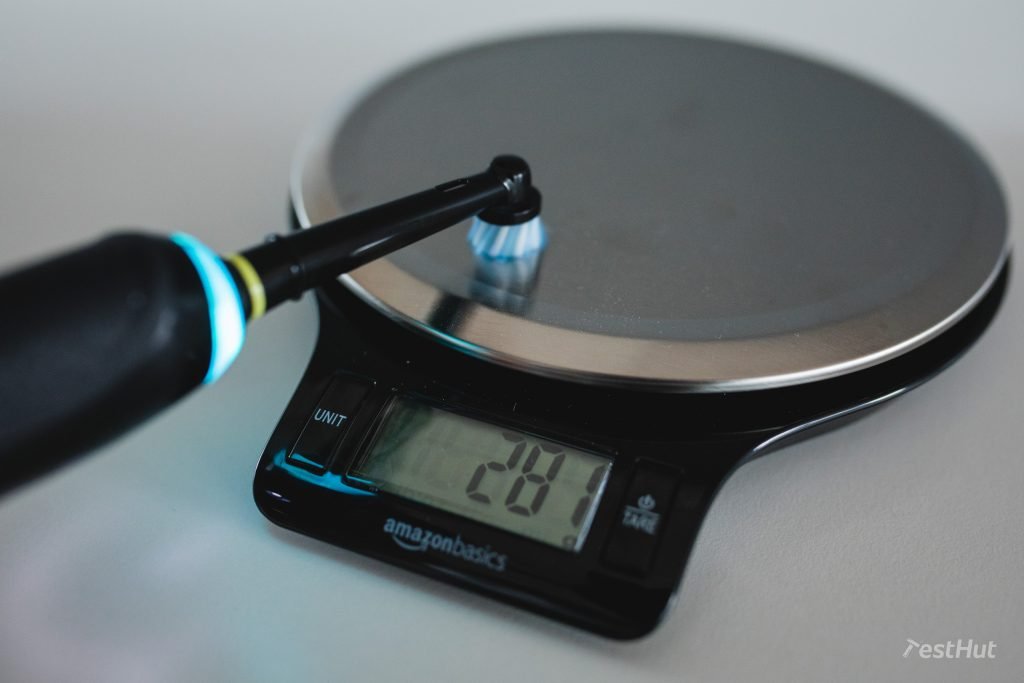
All of the brushes we tested had at least two modes, the most common being a daily clean mode and some kind of low intensity/sensitive mode which lowered the power for a gentler cleaning. Other common modes are whitening and deep clean, neither of which we found to be very useful. Some brushes also allow you to vary the intensity to increase or decrease the strength of the vibrations. To score modes and intensities, we gave an objective score to those brushes with the most modes and the most customizable use of these modes. For example, brushes with just 2 modes were given 2 points, and those with at least 5 modes were given 5 points. We also took a point off if the brush did not have mode memory, which means that it will start in a default mode rather than the last mode you used.
Features results
The most important of these features is an accurate timer and quadpacer (or hexpacer in the DiamondClean’s case) because this feature helps you brush for the right amount of time and to get your whole mouth clean, so we weighted this at 60% of the total score.
A pressure sensor is also important for your overall oral health to make sure you are not brushing too hard and damaging your teeth or gums, so we weighted this at 35%.
We do not think multiple modes are an important feature to achieving a clean healthy smile. We wanted to give some credit for these features, but because they are not necessary we only weighted them at 5%.
| Toothbrush | CATEGORY OVERALL | Timer and quadpacer (60%) | Pressure sensor (35%) | Modes, intensities (5%) |
|---|---|---|---|---|
| Philips DiamondClean Smart | 5.0 | 5 | 5 | 5 |
| Oral-B Genius X | 5.0 | 5 | 5 | 5 |
| Oral-B iO 7 | 4.7 | 5 | 4 | 5 |
| Philips Sonicare 4300 | 3.9 | 4 | 4 | 2 |
| Oral-B Pro 3000 | 3.7 | 3 | 5 | 2 |
| Oral-B Pro 2000 | 3.7 | 3 | 5 | 2 |
| Oclean X Pro | 3.6 | 5 | 1 | 4 |
| Xiaomi Mi | 3.6 | 5 | 1 | 5 |
| Oclean One | 3.0 | 4 | 1 | 5 |
| PlayBrush | 2.9 | 4 | 1 | 3 |
| Atmoko | 2.7 | 4 | 0 | 5 |
| Fairywill P11 | 2.0 | 3 | 0 | 3 |
The DiamondClean Smart and Oral-B Genius X tied for first place in this category, which you might expect since they are both flagship models from these manufacturers. Both had perfectly accurate pacers, visible, consistent pressure sensors, and both offer several modes to choose from giving you lots of options while brushing. The DiamondClean Smart also offers 3 intensities (low, medium and high) to go with each mode, so you can customize your brushing experience.
The iO 7 scored just below these two with 5 modes and an accurate quadpacer, losing one point for its pressure sensor which is more sensitive than the others. While it does include an innovative sensor that tells you when you are applying the correct amount of pressure, we found that this triggers at just 50 grams of force which is lower than the recommended ideal pressure of about 150 grams.
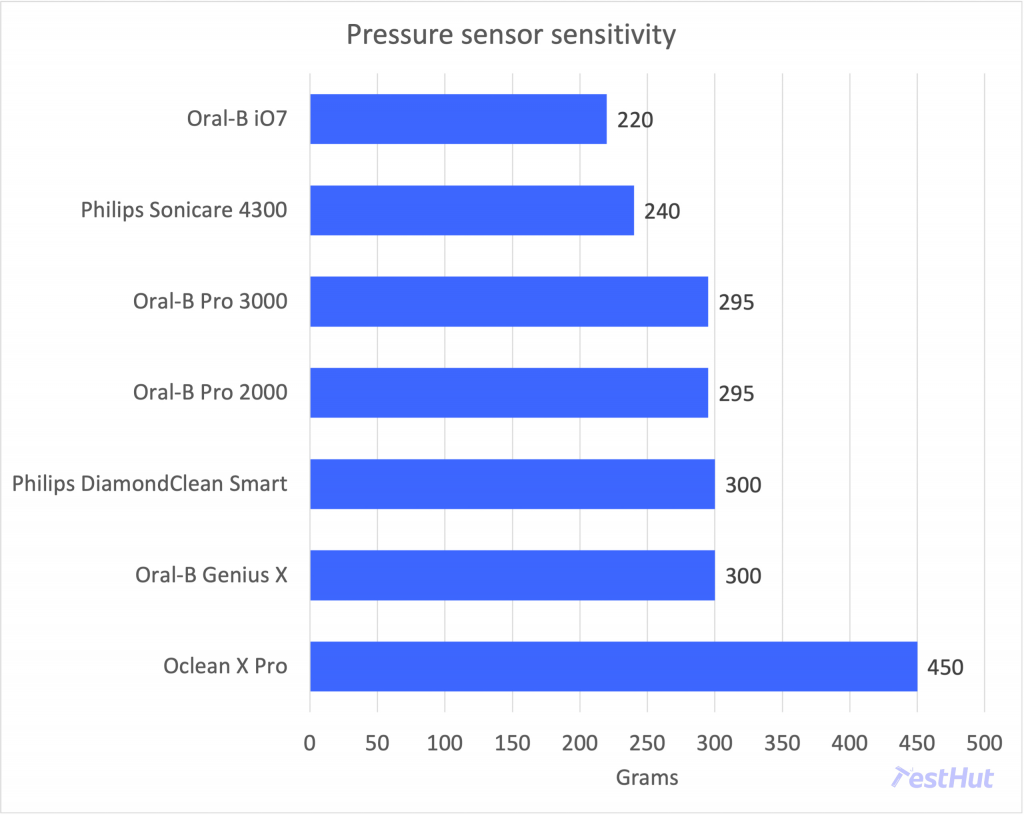
The Sonicare 4300 earned 4 points for the timer and quadpacer since it offers no customization to the brushing time. The pressure sensor works well, but we felt that it was overly sensitive and actually became annoying at times going off at just 240 grams of force, and the overpressure indicator light on the handle is tiny. It comes with only 2 intensities and no modes.
The Oral B 3000 and 2000 stop for a second between quadrants during a 2-minute session which means that you only get 1:56 of cleaning time. They also offer no customization, and while other brushes allow you to pause the brush and restart where you leave off, if you stop in the middle of a session, the 2-minute timer starts all over. These had excellent pressure sensors with bright visible lights, but they only offer 2 modes to choose from.
The Xiaomi scored just below the two Oral-B brushes. It has a perfect quadpacer and a nice, customizable selection of modes. However, it does not have a pressure sensor.
We were also impressed with the Oclean X Pro for its precise timing and ability to adjust brushing time from 2-4 minutes via the app without any issues. This brush lost a point because it has too many intensities (32 to choose from) making it confusing as to what level to use for optimum cleaning. It also scored a 1 for its pressure sensor because it does not have an active, visible pressure sensor that we were able to test. The X Pro claims to have a sensor, and the manufacturer told us that it operates as part of the AI system, but in our tests, we exerted almost a kilogram of force before we noticed that the vibrations slowed. This is over 3x the recommended pressure.
The Oclean One lost a point for its timer and quadpacer because it does not allow you to pause in the middle of a session, and for some reason, it loses half a second on startup. It also has no measurable pressure sensor, but it does have 3 modes with multiple intensities allowing for customized brushing regimes.
The Playbrush, like the Oral-B 2000, loses 2 seconds during a 2-minute session because of its pauses between quadrants. It does allow you to customize your brushing time via the app, and also allows you to stop the brush and restart without losing time. Again, Playbrush claims that this brush has a pressure sensor but our tests were not able to detect one. It does have a motion sensor which will activate if you brush too quickly, with an orange light flashing on the base. We also took points off for modes because it only has 3 modes with no customization options.
The Atmoko brush has 5 modes with mode memory, so that is good. However, it has no pressure sensor. It also stops completely between quadrants and does not have a pause feature.
The Fairywill scored the lowest in this category. It has a full-second pause between quadrants, no pause feature, and the timer was not a full 2-minutes. It has no pressure sensor, but it has 3 modes to choose from.
How we tested: Build quality and design
When you buy a toothbrush, you may feel like it is a personal statement, so you want it to reflect your taste. Build quality and durability are also very important to ensure the longevity of the brush you choose. This category was worth 10% of the total score.
To test durability, we dropped each brush from a bathroom sink to a hard-tiled floor. To be honest we saved this test for last because we were afraid that the brushes would break.
Feel and finish was a more subjective test based on our assessment of the build quality of the brush handles. We looked at the materials used to make the brush, the fit and finish, and how all the pieces and parts fit together.
Aesthetic design is another subjective category based on the overall style of the brush. We compared each brush side by side, and made notes about the style, shape and design. We looked at how the materials and colours complement one another, and how well the brush heads fit and seamlessly continued the line of the handle.
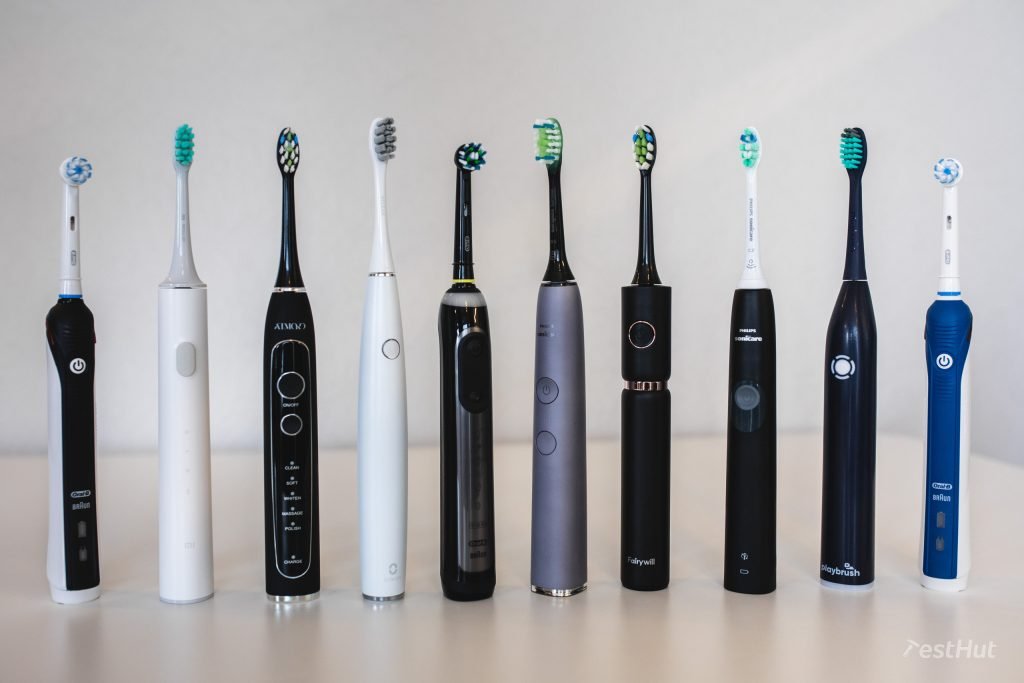
To test water resistance, we submerged each brush in a sink full of water and then tested it to make sure that it still functioned properly.
Brush head quality includes several factors such as indicator bristles, labeling of the brush type, quality of bristles, how well they fit on the handle, colour and overall design.
The final category is colour options. We gave higher marks to those brushes that offer the buyer a variety of colours to choose from.
Build quality and design results
The two most important subcategories are durability and fit and finish because you want your brush to last and feel like it is a quality product, so we weighted these both at 25%.
Aesthetic design is an important factor for many people, so we felt this deserved a 20% weighting. This is followed by water resistance at 15%, then brush head quality at 10% and colour options, which is the least important, worth just 5%.
| Toothbrush | CATEGORY OVERALL | Durability (25%) | Feel and finish (25%) | Aesthetic design (20%) | Water Resistance (15%) | Brush head quality (10%) | Available color options (5%) |
|---|---|---|---|---|---|---|---|
| Philips Sonicare 4300 | 5.0 | 5 | 5 | 5 | 5 | 5 | 5 |
| Oral-B iO 7 | 4.9 | 5 | 5 | 5 | 5 | 5 | 2 |
| Oclean One | 4.8 | 5 | 5 | 5 | 5 | 4 | 3 |
| Philips DiamondClean Smart | 4.7 | 5 | 4 | 5 | 5 | 5 | 3 |
| Oclean X Pro | 4.6 | 5 | 4 | 5 | 5 | 4 | 4 |
| Oral-B Genius X | 4.4 | 5 | 4 | 4 | 5 | 5 | 2 |
| PlayBrush | 4.4 | 5 | 4 | 4 | 5 | 4 | 3 |
| Xiaomi Mi | 4.3 | 5 | 4 | 4 | 5 | 4 | 1 |
| Oral-B Pro 2000 | 4.3 | 5 | 4 | 3 | 5 | 5 | 4 |
| Oral-B Pro 3000 | 4.2 | 5 | 4 | 3 | 5 | 5 | 2 |
| Atmoko | 4.2 | 5 | 4 | 4 | 5 | 3 | 1 |
| Fairywill P11 | 3.9 | 5 | 3 | 4 | 5 | 3 | 1 |
We are happy to say that all of the brushes we tested survived our durability and water resistance tests. We dropped them onto the bathroom floor and then submerged them in a sink full of water, and they all continued to work without any issues.
Other scores were a bit more subjective. The Sonicare 4300 was perfect in this category because of its high quality feel and finish coupled with a modern, attractive design.
The new Oral-B iO 7 is quite an improvement in overall design over its predecessors. It is sleek with clean lines and a nice finish. While not as premium looking as the DiamondClean, it is a nice looking brush. It did lose points in this category for only being available in white. Higher-end iO brushes do also come in black.
We also like the design of the DiamondClean Smart, and both of the Oclean brushes earned the highest marks as well. However, the Oclean One and DiamondClean come in a limited number of colours. And the DiamondClean lost a point for fit and finish because of the cheap looking and feeling plastic chrome accent at the base of the handle.
For as much as the Oral-B Genius X costs, it does not have the modern design of some of the other brushes, and it looks and feels a bit dated. It is a quality brush, but it is available in just two colours.
The Playbrush also feels relatively well designed and built, aside from its utilitarian plastic coating. However, it also comes in a limited number of colours.
Xiaomi has a reputation for simple, modern design, and the Mi is just that. It is a cylinder shape, which is not as aesthetic or as comfortable as some of the other brush handles, but the overall finish has a quality feel. However, it only comes in one colour, off-white with grey accents.
The other Oral-B brushes were even less attractive with two-tone plastic finishes. They feel very sturdy, and as with all Oral-Bs they have quality brush heads. The 2000 scored just a bit higher than the 3000 because it is available in more colours.
At the bottom of this category is the Atmoko which comes in just one colour and has a stiff, cheap feeling brush head. It is followed by the Fairywill which does not feel like it is well-built wrapped in cheap plastic with visible seams, and it is also available in just one colour.
How we tested: Battery life and charging
One of the most frustrating things about rechargeable devices is when they run out of juice when you need them most. We felt that battery life and the charging experience of these brushes was an important area to focus on. This category was worth 10% of the total.
In our lab test, we charged each toothbrush fully, and then ran them through a normal 2-minute cleaning cycle until they were completely dead, counting how many sessions we got on a full charge.
To test the charging time, we set up all the brushes on chargers after being completely discharged and then filmed a timelapse movie while they charged. From this video, we used the timestamp to determine how long it took to charge each brush. We further confirmed these results with individual charging tests. We also scored the brushes for the quality of the charger, length of cord, and overall ease of the charging process itself.
We also scored the battery indicator by giving the highest points to brushes with built-in indicator lights that show actual battery life along with an in-app battery percentage view (for smart brushes).
Battery life and charging results
Battery life is the most important feature so it was weighted at 60%. Charging was 30% and the battery indicator was 10%.
| Toothbrush | CATEGORY OVERALL | Battery life (60%) | Charging (30%) | Battery indicator (10%) |
|---|---|---|---|---|
| Oclean One | 4.6 | 5 | 4 | 4 |
| Fairywill P11 | 4.3 | 5 | 4 | 1 |
| Philips DiamondClean Smart | 4.3 | 5 | 3 | 4 |
| Philips Sonicare 4300 | 4.3 | 5 | 3 | 4 |
| Oclean X Pro | 3.7 | 3 | 5 | 4 |
| Atmoko | 3.5 | 4 | 3 | 2 |
| Oral-B Genius X | 3.4 | 3 | 4 | 4 |
| Oral-B Pro 3000 | 2.8 | 3 | 3 | 1 |
| Oral-B Pro 2000 | 2.8 | 3 | 3 | 1 |
| PlayBrush | 2.2 | 2 | 2 | 4 |
| Oral-B iO 7 | 2.1 | 1 | 4 | 3 |
| Xiaomi Mi | 2.0 | 1 | 3 | 5 |
The Oclean One took top marks in our battery life tests. It has by far the longest life reaching 63.5 days in our lab test. It has an incredibly fast magnetic charging base with a USB plug which took only 4 hours to fully charge the brush. The battery indicator on the handle could be more clear. It starts to blink when the battery is at 5% power, but it still earned high marks because the app shows the exact percentage of battery life.
Next was the Fairywill which also has an excellent battery life at 48 days and an incredibly fast charging time of under 2 hours. However, we did take a point off the charging score because this is the only brush in our test that does not come with a charging stand. You have to lay it on its side and plug it in via a USB adapter with a proprietary plug. The indicator is also not very visible with dim lights on the handle.

Both Sonicares impressed us with their battery life. Philips claims just 2 weeks of life for both brushes, but the DiamondClean got 37 days in our test, and the 4300 made it to over 49 days. Both brushes use induction chargers—the DiamondClean Smart has a signature glass charging cup, while the 4300 has a more traditional stand both with standard wall plugs. The DiamondClean took about 18 hours to charge while the 4300 took 13 hours. Both have decent battery indicators on the handle which blinks green at about 50%, then amber at 10% and finally red when the battery is dead. They also beep to let you know that they need to be charged. The DiamondClean also has an in-app indicator, but it does not show an exact percentage and you have to swipe through 3 screens to find it.
The Oclean X Pro has a decent battery life reaching 24 days. It took just under 2 hours to charge with a stable magnetic charging base and USB plug. The touch screen displays battery life, and when the battery is low, a prompt appears on the screen. At 1%, the handle vibrates and the screen turns off letting you know that you need to charge it.
Atmoko claimed that their brush would go 4 weeks between charges, and in our test, it made exactly 28 days. This brush came with a stable induction charger using a USB plug that charges the handle in about 13 hours. The indicator is a bit simplistic and can be confusing because it blinks red when the power is low, but also alternates blinking green and red, so sometimes it was hard to tell what that meant.
Next up are the brushes from Oral-B. All of these have about the same battery life. We got 18.5 days from the 2000 and 3000 and 17.5 days from the Genius. The Oral-B brushes all came with induction stands and standard wall plugs. The Genius X’s charger is a bit larger and bulkier than the other models. Charging time was about 13 hours for the Pro models and 12 for the Genius. The Genius has a much better battery indicator with 3 bars on the handle to let you know how much life is left. The 2000 and 3000 have a single light which turns red only when the battery needs to be charged. This is a problem with Oral-B brushes because when the battery is low, they automatically reduce brushing power meaning that your last session may be compromised without warning. All the other brushes we tested run on full power until they die.
The iO 7 scored a bit higher than the other Oral-Bs because it charges much faster—just 3 hours. But the battery life is average at best, giving us about 2 weeks of brushing on a single charge.
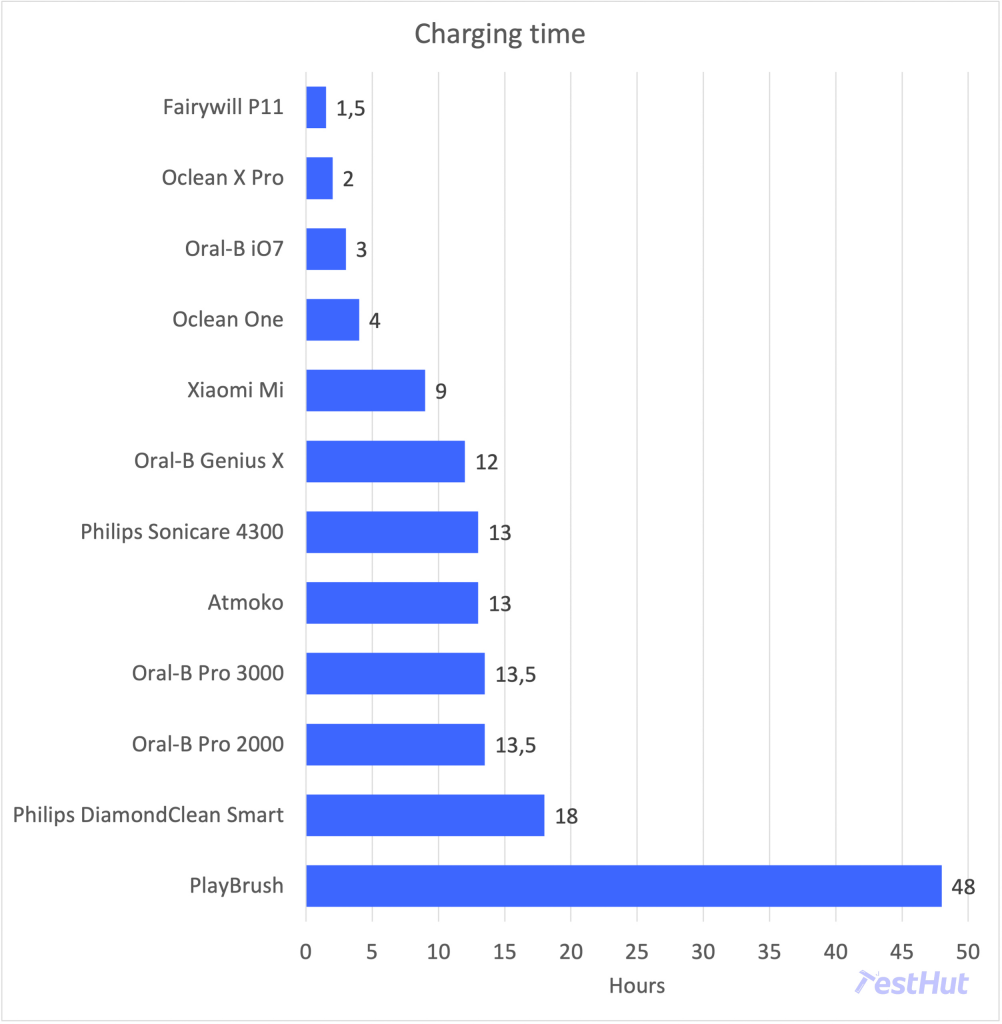
The Playbrush is still a bit of a mystery in the battery category. The first model we had seemed to fail after we discharged and tried to charge it. It would not hold a charge. After experimenting with the replacement, we figured out that it was likely the original induction charger itself that was faulty. In our lab test, we were able to coax 15.5 days of cleaning on a single charge, but in a second test, we got many more. It has an annoying battery light at the base of the handle that starts to blink red when it needs to be charged. It is much brighter than necessary. It also has a battery indicator in the app, which is green when the battery is full, orange when it is low, and red when it needs to be charged. It comes with a standard induction charger and wall plug. When we let the model run out of power completely, it took over 24 hours to fully charge. But if you charge the brush regularly when it is low on power but not completely drained, the time is more in line with the other brands we tested.
The Xiaomi Mi earned the lowest score in this category. It was the only brush that ran out of power in less time than the manufacturer claimed—just 10 days while Xiaomi claims 18. We tested it again and again, but we never got more than 20 sessions on a single battery charge. The induction charger is stable and has a USB plug with no adapter. It charges the brush in just 9 hours. This earned the highest score for battery indicator because the handle will display green, blinking orange, and blinking red as the power drains, and the app shows the exact battery percentage.
How we tested: Box contents
Whilst we do not feel that the box contents are that important, you should be aware of what you get when you buy your brush. With many people buying things online, you also want to make sure that your package is secure. In addition, it is nice to have extra brush heads, and we found the travel case to be a convenient accessory. This category was worth just 5% of the total score.
Truth be told, one of the most exciting moments for the TestHut team was when our brushes arrived in their boxes, and we got to unbox them. We took careful notes of the outer boxes and the condition after shipping, the inner packaging and the instruction manuals before we even looked at the brushes themselves.
Then we gave points for an included travel case. We also gave points for extra brush heads. Additionally, there were some other accessories (brush holder, brush head cap, etc.) that we felt deserved credit, so we scored those as well.
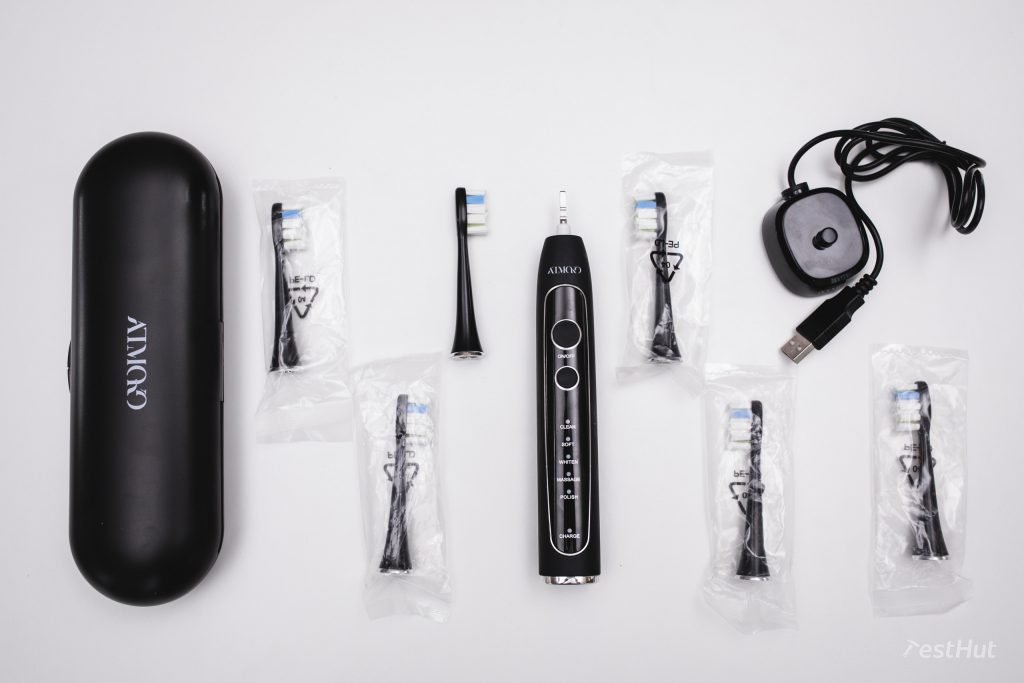
Box contents results
We felt that the most practical and useful accessory was a travel case, so we weighted this at 60% of the total. Brush heads are obviously nice to have as well, so they were worth 15%.
Next were the instruction manual and other accessories which were 10% followed by packaging which was 5% of the total.
| Toothbrush | CATEGORY OVERALL | Travel case (60%) | Included brush heads (15%) | Instruction manual (10%) | Other accessories (10%) | Packaging (5%) |
|---|---|---|---|---|---|---|
| Philips DiamondClean Smart | 4.7 | 5 | 4 | 4 | 5 | 4 |
| Oral-B Genius X | 3.8 | 4 | 4 | 5 | 0 | 5 |
| Oral-B iO 7 | 3.5 | 3.5 | 2 | 5 | 4 | 4 |
| Oclean X Pro | 3.5 | 4 | 1 | 3 | 4 | 5 |
| Oral-B Pro 3000 | 2.7 | 3 | 2 | 4 | 0 | 4 |
| Oclean One | 2.5 | 3 | 1 | 3 | 0 | 5 |
| Atmoko | 2.5 | 2 | 5 | 4 | 0 | 3 |
| Fairywill P11 | 2.5 | 2 | 4 | 3 | 2 | 4 |
| Philips Sonicare 4300 | 1.8 | 2 | 1 | 2 | 0 | 4 |
| Xiaomi Mi | 1.8 | 1 | 1 | 5 | 3 | 5 |
| PlayBrush | 1.6 | 1 | 1 | 3 | 3 | 5 |
| Oral-B Pro 2000 | 0.8 | 0 | 1 | 4 | 0 | 4 |
The DiamondClean Smart was a big winner in the box contents category, as you would expect for the premium price. It came with a premium travel case, the best in our test. Not only was it stylish and sturdy, but it also came equipped with a USB charger which is very convenient. Our package included 4 brush heads, a fairly thorough instruction manual and the most other accessories of any package. It included a tongue cleaning kit with a special brush and mouthwash along with a special glass charging cup.
As you may expect, the Oral-B Genius X was next. We opted for the Luxe edition which came with a decorated travel case. However, it does not have a built-in charger like the DiamondClean’s. It came with 4 CrossAction brush heads and a thorough instruction manual. The packaging was premium, but there were no other included accessories.
The Oral-B iO 7 has a premium price, but the box contents were not as nice as the Genius X or DiamondClean. It came with the handle, charger, only one brush head, a basic travel case, and a necessary brush head holder. It is necessary because the iO brush heads do not stand up on their own because of the angled base. The new box design is much more modern than the other Oral-Bs we tested, and the manual is premium with full-color images. We also liked the fit and finish of the X-Pro case better than the basic case from Oral-B—it holds the brush snugly, while the iO case allows the brush to move around.
Next was the Oclean X Pro. We really liked the minimalist packaging that Oclean has adopted. It is “Appleesque” in its simplicity with its clean lines and white box. Our X Pro travel case was not as stylish as the higher-end brands, but it was functional and lightweight. Only one brush head was included, and the instruction manual was not detailed enough for this brush. It does include a unique magnetic wall mount which we think is very practical for storing the brush.
The Oral-B Pro 3000 comes with a functional, albeit unattractive, plastic travel case. It will hold the brush and two brush heads for you, but it will not win any awards for style with its coffin-like appearance. Our package included 2 brush heads (CrossAction and Whitening). We were disappointed to find old-fashioned Styrofoam in the box while most other brands have moved to more environmentally friendly packaging. The instruction manual is okay, but it could be more detailed.
Like the X Pro, the Oclean One came in a stylish package, but its travel case is not as nice or convenient as the X Pro’s. It is long and holds the brush with the brush head attached, so it takes up lots of space. Our package only came with one brush head, and the instruction manual was not as detailed as it should be for a smart toothbrush.
The Atmoko came in a relatively cheap cardboard box with a simple travel case that is functional but flimsy. It did include 6 brush heads, which means you won’t have to buy more for over a year! The instruction manual was thorough enough for this simple brush, but it came with no other accessories.
Fairywill has developed an impressive black box with a magnetic clasp. Each item inside was nestled in its own box with a gold label. We were initially impressed by this, but that feeling soon wore off. We also liked the unique travel case at first, which slides open instead of being hinged with a clasp like all the other cases we tested. It seemed compact and secure. But after one use, we noticed that the fit was so tight, that the case actually scratched our brush handle. Our package came with 4 brush heads for a full year of brushing. The Fairywill also came with a strange accessory, a small adapter that fits on the end of the charging cable which has a USB C and micro USB plug. It doesn’t fit the toothbrush, but it works in a pinch if you need to charge something else.
The Sonicare 4300 is a minimalist toothbrush that came in a secure box, but with more plastic than we would like. It included a travel case, but we were very disappointed in the lack of quality in its design. The handle did not snap into the case or fit snugly, and the clasp was broken. It opened up while traveling. It only included one C2 brush head, and the instruction manual was just a fold out with a few instructions. No other accessories were included.
Xiaomi did a nice job of packing their brush into a compact box which, like the Ocleans, has an Apple-like quality to it. The instruction manual written in 7 languages is very detailed for the most part, but we still aren’t sure about the warranty. This brush does not come with a travel case, but it has a protective cap for the handle and the brush head. The only accessories were coloured rings, and the idea is that you can customize your handle to distinguish it from other members of your household who may have the same brush. It came with just 1 standard brush head.
The Playbrush packaging was a bit unique in its playful style. The box was square-shaped with lots of wording in pastel colours. It had a full-colour manual with photos, but the actual information was a bit lacking. This came with no travel case, but did have a protective cap for the brush head. It only came with one standard brush head, but they also included a plastic accessory to hold your phone to the wall in your bathroom which is convenient when you want to use the app while brushing.
In last place for this category was the Oral-B 2000 which basically just came with the handle, a single brush head, charger, and instruction manual. The packaging included too much Styrofoam, but the instruction manual was pretty thorough.
TestHut’s buying guide for electric toothbrushes
With all the different models and styles to choose from, we wrote a guide to help you find the perfect toothbrush for your lifestyle. First of all, what is the difference between a sonic and an oscillating toothbrush?
Sonic vs. Oscillating brushes
When you buy an electric toothbrush, you have two main options to think about. Do you want a sonic brush or oscillating brush?
Oral-B’s oscillations
Oral-B, one of the biggest brands on the market and a name synonymous with toothbrushes, offers their recognizable round-shaped brush heads that oscillate back and forth to clean your teeth. Most of their brushes also pulsate rapidly in addition to oscillating so you get two types of cleaning.
In our experience, we found that these brushes were not more effective than the high-end sonic toothbrushes. They clean well, but not noticeably better.
Most of the testers found that the pulsating and oscillating was actually a bit uncomfortable. One tester, who had been using a Sonicare for years, complained that the Genius X hurt his gums. The oscillating action was also much louder than the sonic brushes we tested.
But there are many who swear by Oral-B and the power of oscillation because they prefer the small round brush heads which offer easy access to back teeth.
Sonic power
The concept of the sonic toothbrush is often misunderstood. Some people believe that the brushes are actually using sonic waves to clean teeth with no physical contact, but this is not true. There are ultrasonic brushes on the market that claim to do this, but we found these claims to be rather questionable.
Sonic brushes generally vibrate the brush head at speeds from about 20,000 to up to 62,000 movements per minute. These vibrations create a dynamic fluid reaction which forces the liquids in your mouth to move rapidly into crevices to clean not only where the bristles meet the surface of the teeth, but between teeth and at the gumline as well.
In our tests, we found that some sonic toothbrushes have this “dancing on the teeth effect”. You can almost feel when they are moving fast enough and are powerful enough to really make them skate along the surface. The weaker brushes in our test felt like dead weight, and you couldn’t feel this dynamic fluid reaction at all. This also resulted in poorer cleaning results.
Many new brushers find this action to be very uncomfortable. When I first tried a sonic toothbrush many years ago, I couldn’t stop laughing because the vibrations were so uncomfortable. Philips addresses this issue by having a break-in period on many models so they start on lower speeds and intensities and after two weeks, they build up to full power. This helps new users become accustomed to the vibrations. With other brushes, they usually come with multiple modes or intensities to help you get started.
Another difference we noticed is that sonic brushes tend to have better battery life. It seems that the vibrations take less effort to produce than oscillations.
The bottom line is that it comes down to personal preference. There are many more sonic brushes out there than oscillating brushes, so this is also something to consider.
Do you need a smart brush?
Our short answer is simply no—no, you do not need to pay extra for smart features. Our favourite toothbrush was the Sonicare 4300 and it is not a smart toothbrush. In our testing, we found that most of the smart features, including multiple modes, are more of a gimmick to sell the toothbrush and make it seem impressive rather than offering actual value.
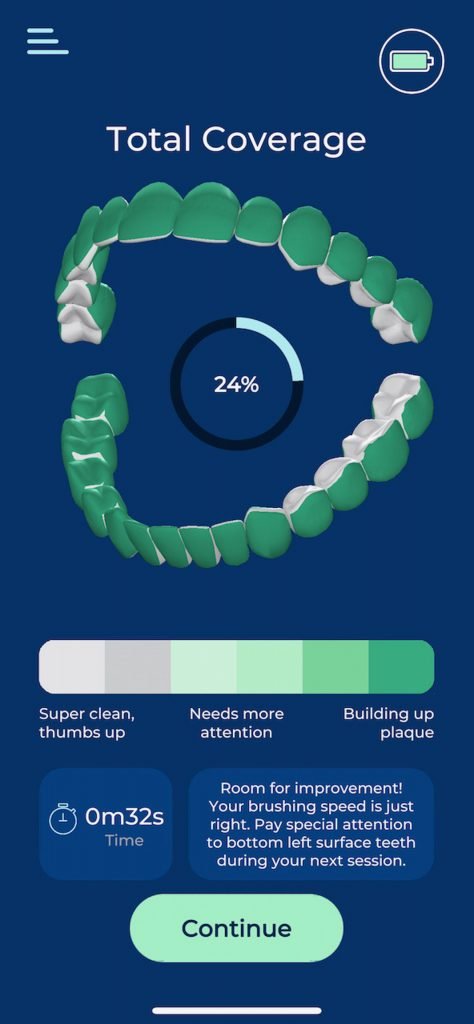
The most important thing an electric toothbrush can do is clean your teeth well. You do not need a smart toothbrush to do that. We think that a quadpacer and pressure sensor are very important, but beyond that, it is just smoke and mirrors.
We do think that some smart features can be helpful. For a new user, the live brushing coach feature from Philips, Oral-B or Playbrush might be able to improve your brushing technique.
Some brushes offer customization features that users might enjoy like the ability to have longer brushing sessions or to program modes to change while brushing.
We also like apps that track how long we have been using the brush head and offer detailed battery life information.
But none of these features will get your teeth cleaner or save you from having to see the dentist regularly. So, if you just want a clean, healthy smile at a decent price, then we suggest you ignore the smart features and just get a reliable, powerful electric toothbrush.
Subscription services
A trend for some electric toothbrush makers is to create subscription services for their brushes so you don’t have to worry about buying new brush heads.

Of our test models, the Playbrush is the only one that focuses its brand on subscriptions. They offer a quarterly or annual service which will deliver new brush heads directly to you at regular intervals. They claim that with the subscription and the app you are actually saving money in the long run. This, of course, depends on whether or not you find value in the app.
Personally, we don’t see much value in subscriptions that lock you into a set price for replacement brush heads. We have found that prices can fluctuate, and you are likely better off buying your own replacements in bulk to save money.
We do like the idea of the convenience of a subscription service. I have used a subscription service for shaving, and very much liked having replacement blades delivered. However, a dull razor is much more noticeable than a used brush head.
You are fine either way as long as you regularly replace your brush head. Most recommendations say that you should get a new brush head every three months, and definitely discard your brush head if you have been ill and buy a new one right away!
How much should I spend?
Ultimately, it is up to you to decide how much to spend on an electric toothbrush. From our tests, we found that you should expect to spend 45 Pounds or more for a quality brush, and you could spend hundreds if you want the top-end model.
The other cost to consider is the maintenance of brush heads. The American Dental Association says that you should “Replace toothbrushes every three to four months or more often if the bristles are visibly matted or frayed.” This means that on top of the cost of the initial electric toothbrush, you will also have to budget for replacement brush heads.
Depending on the brush, a single brush head can cost anywhere from 2-13 Pounds. We found that the newest 3 series brush heads from Philips and the new Oral-B iO line are the most expensive, while most other manufacturers are relatively cheap. We would recommend doing some initial research before you buy your brush.
Just remember the old adage: you get what you pay for. In our tests, we found this to be generally true. The more expensive brushes from reputable companies performed better, on average, than brushes that cost less. The big exception was the Xiaomi Mi, which performed reasonably well in all of our tests despite being the least expensive brush.
One other thing to consider are the accessories you get with your brush. Do you need a travel case? How important are those extra modes and features? We don’t think that it is worth paying a premium for a smart toothbrush. Take all of this into account and then buy the best brush for your budget!
Conclusion
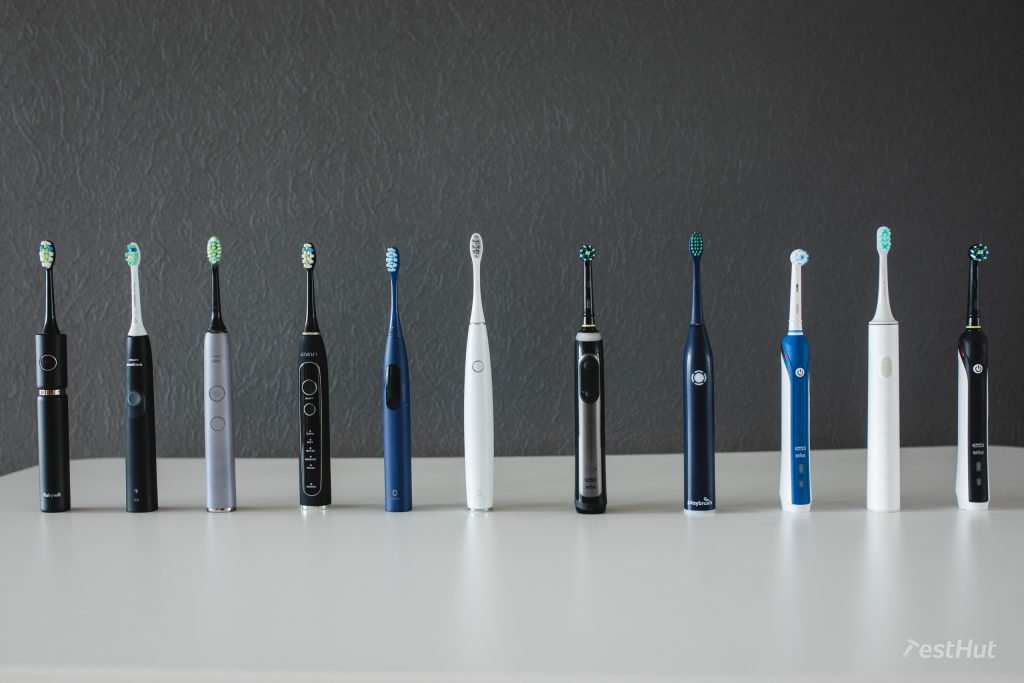
We had a lot of fun testing all these different brushes. There were some interesting surprises along the way, and we learned a lot. And we agree that our teeth are as clean as they have ever been!
All of these brushes will continue being tested in long-term tests and we will update you with the results as they come in. Our biggest concerns are about durability and longevity, and we will find out which brushes last the longest.
When the toothpaste settled and the plaque revealing pills had faded, we had a clear winner along with a number of respectable challengers: the Sonicare 4300 impressed us with its cleaning power and comfort and we highly recommend it as our Top Choice.
If you have a desire for luxury, then go for our Premium Option, the DiamondClean Smart. For travelers, we think the Oclean X Pro with its excellent travel case is a clear winner. For the tech savvy customer, we think that Oral-B offers the best smart brush with the Genius X. We hope that after all this, you find the right toothbrush!
Sources
- Johnston, Casey, et al. “The Best Electric Toothbrush.” Wirecutter, The New York Times, 2021., www.nytimes.com/wirecutter/reviews/best-electric-toothbrush/.
- “Seal Product Shopping List.” Shopping List of All Products with the ADA Seal of Acceptance, American Dental Association, 2021., www.ada.org/en/science-research/ada-seal-of-acceptance/ada-seal-shopping-list.
- “Electric Toothbrushes: Sonicare.” Philips, Koninklijke Philips N.V., 2021., www.philips.co.uk/c-m-pe/electric-toothbrushes.
- “Electric Toothbrushes; Dental Health: Oral-B.” Oral-B UK, 2020 Procter & Gamble, 2021., www.oralb.co.uk/en-gb.
- “Elektrische Zahnbürsten. Für jeden die passende Bürste.” Test.de, 2021., https://www.test.de/Zahnbuersten-im-Test-4621863-0/.
- “Electric toothbrushes.” Which.co.uk, 2021., https://www.which.co.uk/reviews/electric-toothbrushes.
- “Elektrische tandenborstels.” Consumenten bond, 2021., https://www.consumentenbond.nl/elektrische-tandenborstel.
- “Electric Teeth (UK) – Dental Health Simplified.” Electric Teeth, 2021., www.electricteeth.com/uk/.
